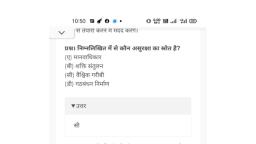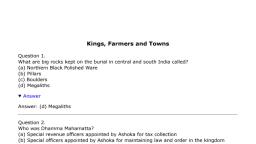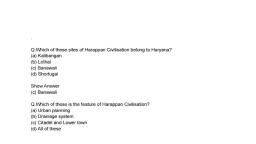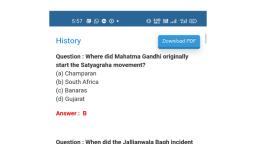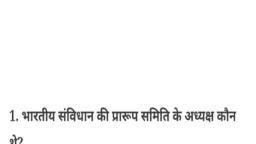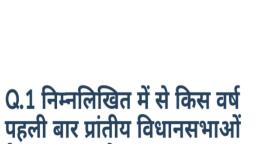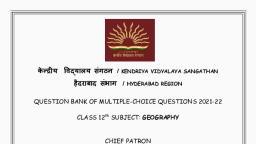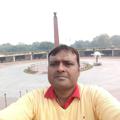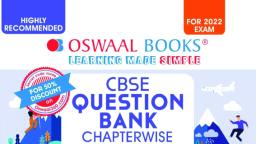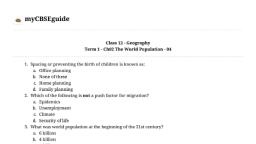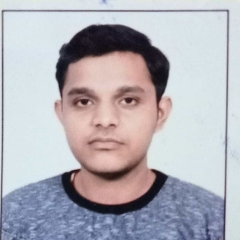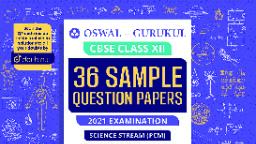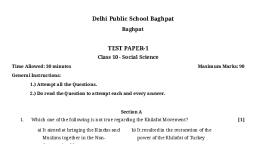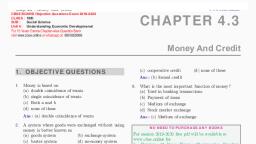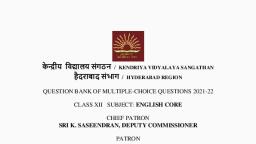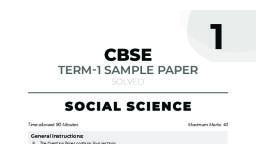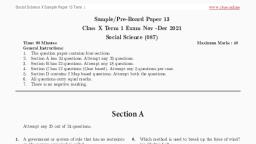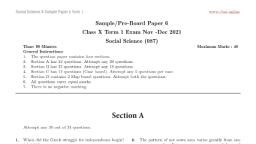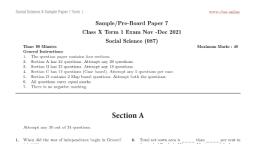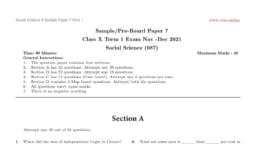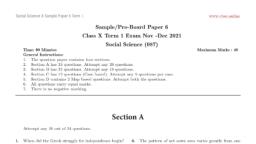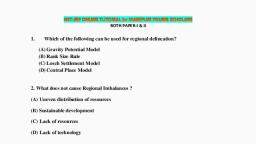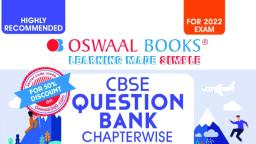Page 2 :
कें द्रीय विद्यालय सगं ठन क्षेत्रीय कायाालय रायपरु, Kendriya Vidyalaya Sangathan Regional Office Raipur, MESSAGE FROM DUPUTY COMMISSIONER, , It is a matter of great pleasure for me to publish study material for different, subjects of classes X and XII for Raipur Region. Getting acquainted and familiarized, with the recent changes in curriculum and assessment process made by CBSE vide, Circular No. 51 and 53 issued in the month of July 2021 will help students to, prepare themselves better for the examination. Sound and deeper knowledge of the, Units and Chapters is must for grasping the concepts, understanding the questions., Study materials help in making suitable and effective notes for quick revision just, before the examination., Due to the unprecedented circumstances of COVID-19 pandemic the, students and the teachers are getting very limited opportunity to interact face to, face in the classes. In such a situation the supervised and especially prepared value, points will help the students to develop their understanding and analytical skills, together. The students will be benefitted immensely after going through the question, bank and practice papers. The study materials will build a special bond and act as, connecting link between the teachers and the students as both can undertake a, guided and experiential learning simultaneously. It will help the students develop, the habit of exploring and analyzing the Creative & Critical Thinking Skills. The, new concepts introduced in the question pattern related to case study, reasoning, and ascertain will empower the students to take independent decision on different, situational problems. The different study materials are designed in such a manner, to help the students in their self-learning pace. It emphasizes the great pedagogical, dictum that ‘everything can be learnt but nothing can be taught’. The self-motivated, learning as well as supervised classes will together help them achieve the new, academic heights., I would like to extend my sincere gratitude to all the principals and the teachers, who have relentlessly striven for completion of the project of preparing study, materials for all the subjects. Their enormous contribution in making this project, successful is praiseworthy., Happy learning and best of luck!, Vinod Kumar, (Deputy Commissioner), 2|Page
Page 4 :
4|Page
Page 5 :
5|Page
Page 6 :
6|Page
Page 7 :
Question Bank CCT based question of Class 12th History, Raipur Region(2021-22), Theme –I : Bricks, Beads and Bones: The Harappan Civilization (chapter 1), Q1.From where did Harappans get gold?, (a) South India, (b) Central India, (c) Himalayan Region, (d) Chotta Nagpur region, Answer (a) South India, Explanation: South India was the main source of Gold. During the period of the Indus Valley Civilization (7380, BC-1500 BC), gold from the Kolar mine in Karnataka, South India, reached Indus Valley sites in what is now, Pakistan., Q2. Consider the following statement:, 1. After independence, most of the Harappan civilization centres went over to Pakistan., 2. The Harappan script has been deciphered., 3. Rulers had an important role in Harappan civilization., 4. Dead were buried in Harappa., Which of the above is correct statement?, (a) 1, 2 and 3, (b) 1, 3 and 4, (c) 1, 2, 3 and 4, (d) 2, 3 and 4, Answer: (b) 1, 3 and 4, Explanation: Harappan Civilization was one the earliest civilization. After Partition of India and Pakistan most, of the part of the Harappan civilization went to Pakistan. From evidences of Harappan Civilization it is comes, to know people were buried after death., Q.3 Consider the following statements about the seals of Proto-Shiva., 1. There is a mention of a diety ‘Rudra’ in ancient religious texts., 2. Later on Rudra word was used for Shiva., 3. Rudra is not mentioned as Pashupati in Rigveda., 4. Depiction of Pashupati does not match the mention of Rudra in Rigveda., Which of the given statements is/are correct?, (a) 1, 2, 3, 4, (b) 1, 2, 3, (c) 2, 3, 4, (d) 1, 3, 4, 7|Page
Page 8 :
Answer: (a) 1, 2, 3, 4, Explanation: The Pashupati Seal (also Mahayogi seal,[1] Proto-Śiva seal;[2]the adjective "so-called", sometimes applied to "Pashupati"),[3] is a steatite seal which was uncovered in the 1928–29 Archaeological, Survey of India excavations of the Indus Valley Civilisation ("IVC") site of Mohenjo-daro, then in the British, Raj, and now in Pakistan. The seal depicts a seated figure that is possibly tricephalic (having three heads). The, seated figure has been thought to be ithyphallic (having an erect penis), an interpretation that has been, questioned by many, but was still held by the IVC specialist Jonathan Mark Kenoyer in a publication of, 2003.[4] The man has a horned headdress and is surrounded by animals. He may represent a horned deity., Q4 Match the following :, (i), , Harappan, , (a) Gujarat, , (ii), , Dholavira, , (b) Jammu & Kashmir, , (iii), , Manda, , (c) Rajasthan, , (iv), , Kalibanga, , (d) Pakistan, , a. (i) d, (ii) a, (iii) b, (iv) c, b. (i) b, (ii) c, (iii) d, (iv) a, c. (i)c, (ii)b, (iii)a, (iv) d, d. (i)a, (ii)b, (iii)c, (iv)d, , Answer: a. (i) d, (ii) a, (iii) b, (iv) c, , Explanation: Harappan Civilization evidences were found in Gujarat, Jammu & Kashmir, Rajasthan and, parts of Pakistan., Q5. One word answer, (i), , Name any two sculptors of Harappa., , Answer 1. Terracotta bull, 2.Mother goddess, , (ii), , Who discovered Harappan Civilasation. Answer. M.S. Vats, , (iii), , Name any two places of Harappan Civilization, Answer: Mohenjodaro, Lothal, , (iv), , Reat Bath found in which place, , Answer: Mohenjodaro, , Explanation: Indus civilization, also called Indus valley civilization or Harappan civilization, the, , earliest known urban culture of the Indian subcontinent. The nuclear dates of the civilization appear to be, about 2500–1700 BCE, though the southern sites may have lasted later into the 2nd millennium BCE., Among the world’s three earliest civilizations—the other two are those of Mesopotamia and Egypt—the, Indus civilization was the most extensive., , 8|Page
Page 9 :
Q6. True/False, (i), , Harappan was the urban civilasation ( ) Answer (True), , (ii), , Harappan people were not do business (, , (iii), , Mohenjodaro is situated in Gujrat (, , (iv), , Harappan people knows writing (, , (v), , Harappan people worships mother goddess (, , ) Answer (False), ) answer (false), , ) Answer (True), ) Answer (True), , Explanation. Harappan civilization was Urban Civilzation. People of Harappa do business with other country, like Mesopotamia. According to evidences people of Harappa worship mother goddess., , 7. Identify the sculpture and choose the correct answer, , (a) Priest King, (b) Mother Goddess, (c) God Shiva, (d) Others, Answer (a) Priest King, Explanation: The popular art of the Harappans was in the form of terra-cotta figurines. The majority are of, , standing females, often heavily laden with jewelry, but standing males—some with beard and horns—are also, present. It has been generally agreed that these figures are largely deities (perhaps a Great Mother and a Great, God), but some small figures of mothers with children or of domestic activities are probably toys. There are, varieties of terra-cotta animals, carts, and toys—such as monkeys pierced to climb a string and cattle that nod, their heads. Painted pottery is the only evidence that there was a tradition of painting. Much of the work is, executed with boldness and delicacy of feeling, but the restrictions of the art do not leave much scope for, creativity., , 9|Page
Page 10 :
Q 8. Which town in Indus Vally Civilasation had no Citadel, (a) Mohenjodaro, (b) Harappa, (c) Chanhudaro, (d) Lothal, Answer: (C) chanhudaro, Explanation: Some of the oldest known structures which have served as citadels were built by the Indus Valley, Civilisation, where citadels represented a centralised authority. Citadels in Indus Valley were almost 12 meters, tall.[2] The purpose of these structures, however, remains debated. Though the structures found in the ruins, of Mohenjo-daro were walled, it is far from clear that these structures were defensive against enemy attacks., Rather, they may have been built to divert flood waters., Q9. Which of these is the feature of Harappan Civilization?, (a) Urban planning, (b) Drainage system, (c) Citadel and Lower town, (d) All of these, Answer: (d) All of these, Explanation: The civilisation's cities were noted for their urban planning, baked brick houses,, elaborate drainage systems, water supply systems, clusters of large non-residential buildings, and new, techniques in handicraft (carnelian products, seal carving) and metallurgy (copper, bronze, lead, and tin), Q10. Which of these was the source of copper for Harappans?, (a) Karnataka, (b) Rajasthan, (c) Andhra Pradesh, (d) Gujarat, Answer: (b) Rajasthan, Explanation: "The Harappans are referred to as a Bronze Age culture," writes Vasant Shinde, "and they used, copper and bronze to manufacture axes, adzes, knives, fish hooks, chisels, pots and pans and jewelry in form of, bangles, beads, or diadem strips., Q11. Which of these was the cause of decline of Harappan civilization?, (a) Climatic Change, (b) Floods, (c) Deforestation, (d) All of these, Answer : (d) All of these, 10 | P a g e
Page 11 :
Explanation: Many scholars believe that the collapse of the Indus Valley Civilization was caused by climate, change. Some experts believe the drying of the Saraswati River, which began around 1900 BCE, was the main, cause for climate change, while others conclude that a great flood struck the area., Q12. Which of these was not worshipped by the Harappan?, (a) Nature, (b) Goddess, (c) Indra, (d) Pashupatinath, Answer: (c) Indra, Explanation: The importance of the worship of the Mother Goddess (Sakti) is proved by the discovery of, numerous terra-cota figurines. The worship of Siva is suggested by the discovery of figure of a deity with three, faces, with horned head dress, seating cross-legged in a Yogic posture, surrounded by animals like buffalo,, rhinoceros, deer, tiger, etc. Two more figures representing Siva have been unearthed also. In these figures Siva, seats in a Yogic posture and plants or flowers emerge from his head. The worship of Siva and Mother Goddess, were widely prevalent. Animal worship is shown by seals and terracotta figurines. Worship of tree, fire, water, and probably sun seems to have been in prominent among the Indus people. The discovery of a few seals, bearing Swastika symbol and Wheel symbol also indicates Sun worship. Swastika is the symbol of the Sun., , Q13. Which of these is the other name of Harappan Civilization?, (i) Aryan civilization, (ii) Indus Valley Civilization, (iii) Vedic Civilization, (iv) Early Civilization, (a) Only (i) and (ii) are true, (b) Only (i) and (iii) are true, (c) Only (ii) and (iv) are true, (d) Only (iii) and (ii) are true, Answer: (c) Only (ii) and (iv) are true, Explanation: Harappan Civilazation was found near the Indus river. Due to the name of Indus river the, civilization got name Indus valley civilization., Q14. Which of the following things were found at craft production centres in Harappan civilization?, 1. Carnelian, 2. Jasper, 3. Crystal, 4. Quartz, (a) 1, 2 and 3, (b) 1,2,3, 4, (c) 2, 3, 4, (d) 2, 4, 11 | P a g e
Page 12 :
Answer: (b) 1,2,3, 4, Explanation: All the works of Harappan art, including figurines of clay and terracota, stone and bronze, sculpture, seals and beads, are products of skilled craftsmen. Harappans produced their own characteristic, pottery which was made glossy and shining. The Harappan artists were skilled sculptors., Q 15. Identify the sculpture and choose the correct answer, , (a) Mother Goddess, (b) Dancing Girl, (c) Priest king, (d) None of these, Answer: (a)Dancing Girl, Explanation: Dancing Girl is a prehistoric bronze sculpture made in lost-wax casting about c. 2300–1750 BCE, in the Indus Valley Civilisation city of Mohenjo-daro, which was one of the earliest cities., Q 16 The false statements about Harappan Civilization, (i), , Harappan people traded with Mesopotamia, , (ii), , Harappan people used bricks, , (iii), , Harappan people followed Hindunism, , (iv), , Harappa was an Urban Revolution, Answer: (iii) Harappan people followed Hindunism, , 12 | P a g e
Page 13 :
Explanation: The significant features of Indus Valley civilization are personal cleanliness, town planning,, construction of burnt-brick houses, ceramics, casting, forging of metals, manufacturing of cotton and, woolen textiles., Q17. Find out which one is not correctly matched, (A) 1921, , -, , (i) Mohenjodaro, , (B) 1921, , -, , (ii) Harappa, , (C) 1955, (D) 1990, , -, , Answer : (A) 1921, , (iii) Lothal, (iv) Dholavira, -, , (i) Mohenjodaro, , Explanation: Mohenjo-daro , meaning 'Mound of the Dead Men'; is an archaeological site in the province, of Sindh, Pakistan. Built around 2500 BCE, it was one of the largest settlements of the ancient Indus Valley, Civilisation, and one of the world's earliest major cities, contemporaneous with the civilizations of ancient, Egypt, Mesopotamia, Minoan Crete, and Norte Chico. Mohenjo-daro was abandoned in the 19th century BCE, as the Indus Valley Civilization declined, and the site was not rediscovered until the 1920s., Q18. Which two strategies are adopted by the archaeologists to identify social differences among the, Harappans?, (i), , Study of burials, , (ii), , Study of script, , (iii), , Study of trade and commerce, , (iv), , Study of artifacts, , Choose the correct option, (a) Both ‘i’ and ‘ii’, (b) Both ‘i’ and ‘iv’, (c) Both ‘ii’ and ‘iii’, (d) Both ‘i’ and ‘iii’, Answer: (b) Both ‘i’ and ‘iv’, Explanation: After the partition of India in 1947, when most excavated sites of the Indus Valley civilisation lay, in territory awarded to Pakistan, the Archaeological Survey of India, its area of authority reduced, carried out, large numbers of surveys and excavations along the Ghaggar-Hakra system in India., Q19. Which of the following metal was not known to the Harappans?, 13 | P a g e
Page 14 :
(a) Bronze, (b) Silver, (c) Copper, (d) Iron, Answer: (d) Iron, Explanation: Variety of metals such as copper, gold, silver was extensively used by the Harappan metal, workers. Minor metals like tin, arsenic, lead, antimony etc. were used for alloying., Q20. Who was the first Director General of the Archaeological Survey of India, (a), (b), (c), (d), , Alexander Cunningham, John Marshall, George Everest, James Princep, Answer (a) Alexander Cunningham, , Explanation: Sir Alexander Cunningham, (born Jan. 23, 1814, London, Eng. —died Nov. 28, 1893, London),, British army officer and archaeologist who excavated many sites in India, including Sārnāth and Sānchi, and, served as the first director of the Indian Archaeological Survey., Q21. From where did Harappans get Tin?, (a) Afghanistan, (b) Central India, (c) Himalayan Region, (d) Rajasthan, Answer : (a) Afghanistan, Explanation: The current evidence indicates that the Harappans got tin from scattered deposits available in, Afghanistan. It is strongly suggested that Shortugai, a trading outpost of the IVC in Northern Afghanistan,, might have had connections to the import of lapis lazuli, tin and camels into the cities of the Indus Valley, Civilization., Q22. The most important industry of harappan at chanhudro was, (a), (b), (c), (d), , Bead making, Brick making, Handloom, Ship building, Answer (a) Bead making, , Explanation: Evidence of shell working was found at Chanhudaro and bangles and ladles were, , made at this site.Harappan seals were made generally in bigger towns like Harappa,, Mohenjadaro and Chanhudaro which were involved with administrative network . An Impressive, 14 | P a g e
Page 15 :
workshop, recognised as Bead Making Factory, was found at Chanhudaro, which included a furnace. Shell, bangles, beads of many materials, stealite seals and metal works were manufactured at Chanhudaro., Q23 The harappan script was written from, (a) Bottom to top, (b) Top to bottom, (c) Left to right, (d) Right to left, Answer (d) right to left, Explanation: The Indus script (also known as the Harappan script) is a corpus of symbols produced by, the Indus Valley Civilization. Most inscriptions containing these symbols are extremely short, making it, difficult to judge whether or not these symbols constituted a script used to record a language, or even symbolise, a writing system. In spite of many attempts,the 'script' has not yet been deciphered, but efforts are ongoing., There is no known bilingual inscription to help decipher the script, and the script shows no significant changes, over time. However, some of the syntax (if that is what it may be termed) varies depending upon location., , Q24. Archeologist have also found evidence of ploughed field at(a) Banawali, (b) Kalibangan, (c) Lothal, (d) Manda, , answer: (b) kalibanga, , Explanation: Kalibangan is a part of the ancient Indus Valley Civilization, located in present Hanumangarh, district. The site was discovered by Luigi Pio Tessitori, an Italian Indologist and linguist. After Independence in, 1952, Amlānand Ghosh identified the site as part of Harappan Civilization and marked it for excavation., Q25. The roads and streets were laid out along an approximate----- pattern, (a) Grid, (b) Triangular, (c) Square, (d) Circle, , Answer: (a)Grid, , Explanation: By 2600 BC, Mohenjo-daro and Harappa, major cities of the Indus Valley Civilization, were built, with blocks divided by a grid of straight streets, running north–south and east–west., Q26. Scholars have estimated that the total number of wells in Mohenjodaro was about ---(a) 400, (b) 500, 15 | P a g e
Page 16 :
(c) 100, (d) 700, , Answer (d) 700, , Explanation: With the excavations done so far, over 700 wells are present at Mohenjo-daro, alongside, drainage and bathing systems. This number is unheard of when compared to other civilizations at the time,, such as Egypt or Mesopotamia, and the quantity of wells transcribes as one well for every three houses., Q27. Which of the following items has not been found in the harappan civilasation, (a) Pottery and ornaments, (b) Iron hand axe, (c) Copper mirrors, (d) Jewelry, Answer : (b) Iron hand axe, •, , Explanation: Piece of Pottery with Indus Script,Cubical Limestone Weight,Faience Slag,Sandstone, , statues of Human anatomy,Copper Bullock cart,Granaries,Coffin burials (Only founded in, Harrapa),Terracotta Figurines Great bath,Granary,Unicorn Seals (Most numbers of it in here),Bronze, dancing girl statue,Seal of a man with deers, elephants, tiger and rhinos around- Considered to be, Pashupati Seal),Steatite statue of beard man,Bronze buffalo were found in harappan civilization., Q28. Harappa is located on the banks of which river, (a) Indus, (b) Chenab, (c) Ravi, (d) Jhelum, Answer: (C) Ravi, Explanation: harappan civilization found in the bank of the Rav river., Q29. The false statement about Alexander Cunningham is, (a) He excavated many sites including Sanchi and Sarnath, (b) He played role in establishing Indian Archaeological Survey of India, (c) He become the first director General of Archaeological department, (d) He was a British doctor., Answer (d) was a British doctor, 16 | P a g e
Page 17 :
Explanation: Sir Alexander Cunningham, (born Jan. 23, 1814, London, Eng. —died Nov. 28, 1893, London),, British army officer and archaeologist who excavated many sites in India, including Sārnāth and Sānchi, and, served as the first director of the Indian Archaeological Survey., Q 30. What was the main feature of the Harappan Civilization?, (a) Town planning, (b) Art and architecture, (c) Administration, (d) Agriculture, Answer: (a) Town planning, Explanation: This civilization is extended far beyond the Indus Valley. The main towns of Indus valley, civilization were Harappa, Mohenjo-Daro, Kalibangan, Lothal. The significant features of Indus Valley, civilization are personal cleanliness, town planning, construction of burnt-brick houses, ceramics, casting,, forging of metals, manufacturing of cotton and woolen textiles. Mohenjo-Daro people had finest bath facilities,, drainage system, and knowledge of personal hygiene.They were equally conscious of plant medicine since there, was occasional warfare.The town planning and other characteristics indicate that a homogeneous indigenous, culture developed., Q31. Where were large granaries found?, (a) Lothal and Dholavira, (b) Kalibangan, (c) Banawali, (d) Harappan and Mohenjodaro, Answer : (d) Harappan and Mohenjodaro, Explanation: The so-called "granary" of Harappa is found on Mound F. It is a brick structure that was built on a, massive brick foundation over 45 meters north south and 45 meters east-west. Two rows of six rooms that, appear to be foundations are arranged along a central passageway that is about 7 meters wide and partly paved, with baked bricks., Q32. Mohenjodaro is located on the banks of which river, (a) Indus, (b) Ganga, (c) Ravi, (d) Jhelum, 17 | P a g e
Page 18 :
Answer : (a) Indus, Explanation: mohenjodaro was found on the banks of the Indus river, Q33.Which of the following is not one of the features of the Harappan writing?, (a) The harappan Script was pictographic and not alphabetical, (b) It has been deciphered by James Prinsep, (c) It had too many signs , somewhere between 375 and 400, (d) The script was written from right to left, Answer: It has been deciphered by James Prinsep, Explanation: 1.It was pictographic in nature as the script consisted of designs of animals,fishes and various, forms of human figure too. 2.It was found to be inscribed on seals, terracota tablets, etc., , Q 34. Identify the picture, , (a) Terracota bull, (b) Horse, (c) Copper bull, (d) Iron bull, Answer : (a) Terracota Bull, Explanation: The famous Bull seal has been discovered from Mohenjo-daro. Terracottas were made up of fire, baked earthen clay which came to be called as Terracotta Figurines. They were either used as toys or objects of, worship and represented birds, dogs, sheep, cattle and monkeys., Q 35. Where Harappan civilization evidence were not found, 18 | P a g e
Page 19 :
(a) Gujrat, (b) Rajasthan, (c) Maharashtra, (d) Chhattisgarh, Answer : (d) Chhattisgarh, •, , Explanation: The Indus River Valley Civilization, 3300-1300 BCE, also known as the Harappan Civilization,, , extended from modern-day northeast Afghanistan to Pakistan and northwest India., , Q36. Harappan trade with which country?, (a) Mesopotamia, (b) France, (c) Germany, (d) Russia, , Answer: (a) Mesopotamia, , Explanation: Other trade goods included terracotta pots, gold, silver, metals, beads, flints for making, tools, seashells, pearls, and colored gem stones, such as lapis lazuli and turquoise. There was an extensive, maritime trade network operating between the Harappan and Mesopotamian civilizations., Q37. Coastal area of harappan civilasation, (a) Kalibanga, (b) Mohenjodaro, (c) Lothal, (d) Banwali, Answer: (c) Lothal, Explanation: Lothal is on the top of the Gulf of Khambat in Gujarat, India, near the Sabarmati River and the, Arabian Sea. It is the most extensively researched Harappan coastal site. A bead factory and Persian Gulf seal, have been found here suggesting that, like many sites on the Gulf of Khambat, it was deeply involved in trade., Q 38. Name two harappan settelments which were specialized centers for making shell objects, (a) Lothal and Kalibanga, (b) Kalibanga and Mohenjodaro, 19 | P a g e
Page 20 :
(c) Nageshwar and Balakot, (d) Manda and Lothal, Answer: (c) Nageshwar and Balakot, Explanation: The two centres for making shell objects in the Harappan Civilisation are Nageshwar and, Balakot. Shell objects like bangles, ladles and inlay were made at these specialized centres., Q39. On the map of India mark and name:, (i) The port settlement of the Harappan civilization, (ii) The settlement where evidence of ploughed field was found., (iii)The first site to be discovered, (iv) The site where the great Bath was found., (v) A tiny settlement devoted to craft production, Ans:, , (i), (ii), (iii), (iv), (v), , Lothal, kalibanga, Harappa, Mohenjodaro, Chanhudaro, , Explanation: The port settlement of the Harappan civilization was found in Lothal. evidence of ploughed field, was found in kalibanga, grat bath was found in Mohenjodaro, the first site of Harappa civilization was Harappa,, craft production was found in chanhudaro, Q40. In the 1960s, the evidence of massacre in Mohenjo-Daro was Questioned by an archeologist named, George Dales. He Demonstrated that the skeletons found at the site did not belong to the same period: Whereas, a couple of them definitely seem to indicate a slaughter, the bulk of the bones were found in contexts, suggesting burials of the sloppiest and most irreverent nature. There is no destruction level covering the least, period of the city,no sign of extensive burning, no bodies of warriors clad in armour and surrounded by the, weapons of war. The citadel, the only fortified part of the city, yielded no evidence of a final defense., From GF DALES, “The Mythical Mohenjo-Daro”, Expedition, 1964., 20 | P a g e
Page 21 :
As you can see,a careful re-examination of the data can sometimes leads to reversal of earlier interpretation., Q1. Name the archeologist who presented this source?, Ans : Jhon Marshall, Q2. Which argument of the destruction of Harappan civilization, does this excerpt indicates?, Ans: This except indicates that the Harappa civilization was destroyed by foreign invasion., Q3. Who corrected this evidence with Rig Veda? Why?, Ans: R.E.M. Wheeler. Rig veda mentions pur, meaning rampart, fort or strong-hold. Indra, the Aryans’ war god, is called purandara, the fort destroyed., Explation : Jhon Marshall archeologist was found harappan civilization. In the 1960s, the evidence of massacre, in Mohenjo-Daro was Questioned by an archeologist named George Dales. REM wheeler corrected evidence, with Rig veda., , Theme-2 Kings, Farmers and Towns: Early States and Economies, MCQ, Question 1., Who deciphered Brahmi and Kharoshtl scripts?, (a) James Princep, (b) Cunningham, (c) Wheelar, (d) John Marshall*, ans:(d) John Marshall*, Explanation:, The inscriptions of Asoka were first deciphered by James Princep in 1837. They are written in, Pali language and in some places Prakrit was used. The Brahmi script was employed for, writing.In the northwestern India Asokan inscriptions were found in Karoshti script., Question 2., How many Mahajanapadas were there?, (a) 17, (b) 14, (c) 18, (d) 16*, ans:(d) 16*, 21 | P a g e
Page 23 :
Question 4, Who appointed Dhamma Mahamatas ?, (a) Bimbisar, (b) Samudragupta, (c) Asoka*, (d) Pandava, ans:(c) Asoka, Explanation:, Asoka, considered to be one of the greatest rulers of India, adopted Buddhism after seeing the, destruction caused by the Kalinga War. After this, he made multiple efforts to spread the, influence of Buddhism. He commissioned the construction of several stupas as well as, appointed officers for the propagation of Dhamma., Dhamma according to Asoka was adopting non-violence, being generous to those in need,, respecting people of other religions, being kind to servants and respectful to elders, being, liberal to Brahmans etc. For the propagation of these ideals. Asoka appointed Dhamma, Mahamatras., Question 5, Who founded the Mauryan Empire ?, (a) Chandragupta maurya*, (b) Bindusar, (c) Asoka, (d) Ajatashatu, ans:(a) Chandragupta maurya, Explanation:, Chandragupta, left a large power vacuum, and Chandragupta took advantage, gathering an army and, overthrowing the Nanda power in Magadha, in present-day eastern India, marking the start of, the Mauryan Empire. After crowning himself king, Chandragupta took additional lands through, force and by forming alliances, Question 6 Fill in the blanks, Sangam is a literature of ………………………language., (a) Tamil*, (b) malayalam, (c) Sanskrit, (d) Marathi, 23 | P a g e, , ans:(a) Tamil*
Page 24 :
Explanation:, Sangam literature, sangam also spelled cankam, chankam, or shangam, the earliest writings in, the Tamil language, thought to have been produced in three chankams, or literary academies,, in Madurai, India, from the 1st to the 4th century ce., Question 7, Fill in the blanks, Harishena was a court poet of……………………….., (a) Chandragupta Maurya, (b) Samudragupta*, (c) Asoka, (d) Chandragupta II, ans:(b) Samudragupta, Explanation:, Harisena, also called Harishena or Hirisena, was a 4th-century Sanskrit poet, panegyrist, and, government minister. He was an important figure in the court of Gupta emperor,, Samudragupta. His most famous poem, written c. 345 C.E., describes the bravery of, Samudragupta and is inscribed on the Allahabad Pillar., Question 8, Consider the following statements about the Mauryan Empire :, 1., 2., 3., 4., , There were 5 major political centres in the Empire., Megasthenese wrote about the Mauryan Empire in his book Indica., Asoka founded the Mauryan Empire in 321 B.c., Asoka used his sources to propogate Buddhism., , Which of the above statements is/are correct ?, (a) 1,2 &3, (b) 1,2 &4 *, (c) 2,3 & 4, (d)1,3 & 4, ans:(b) 1,2 &4, Explanation:, The Mauryan Empire, which formed around 321 B.C.E. and ended in 185 B.C.E., was the first, pan-Indian empire, an empire that covered most of the Indian region. It spanned across central, and northern India as well as over parts of modern-day Iran., The Mauryan Empire’s first leader, Chandragupta Maurya, started consolidating land as, Alexander the Great’s power began to wane. Alexander’s death in 323 B.C.E. left a large power, vacuum, and Chandragupta took advantage, gathering an army and overthrowing the Nanda, 24 | P a g e
Page 25 :
power in Magadha, in present-day eastern India, marking the start of the Mauryan Empire., After crowning himself king, Chandragupta took additional lands through force and by forming, alliances., Question 9., Which was the first capital of Magadha?, (a) Pataliputra, (b) Kalinga, (c) Rajagaha*, (d) None of the above, ans:(c) Rajagaha, Explanation:, Magadha was an ancient Indian kingdom that was located in the southern Bihar, and was, counted as one of the sixteen Mahajanapadas, that is, 'Great Kingdoms' of ancient India., Magadha played a crucial role in the development of Jainism and Buddhism, the Maurya, Empire and Gupta Empire which are two of India’s greatest empires, originated in Magadha., Question 10 Fill in the blanks, The earliest capital of Magadha was Rajagaha which means ________., (a) house of the king*, (b) house of the people, (c) house of the animals, (d) None of the above, Explanation:, , ans:(a) house of the king, , Rajgir (historically known as Rājagṛiha) meaning "House of the Kings" is an ancient city and ..., Pali: Rājagaha) was the first capital of the kingdom of Magadha, Question 11, Bihar., a) Rajgir *, b) Patna, c) Orissa, d) Rajasthan, Explanation:, 25 | P a g e, , Fill in the blanksThe Prakrit name of Rajagaha is present day _______ in, , ans:(a) Rajgir
Page 26 :
Rajagaha (present-day Rajgir) was the early capital city of Magadha. It was a fortified, settlement. It was located among the hills. In the 4th century BCE Pataliputra, present-day, Patna became Magadha's capital., Question 12 Fill in the blanksMagadha is present day ___________ state., (a) Karanataka, (b) Patna, *, (c) Orissa, (d) Bihar, ans:(b) Patna, Explanation:, Same as question 11, Question 13, Fill in the blanks, Pataliputra is present day ___________ state., (a) Karanataka, (b) Patna, *, (c) Orissa, (d) Bihar, ans: (b) Patna, Explanation:, Same as question 11, Question 14, One of the political center mentioned is Asokan inscriptions Suvarnagiri is also known as, (a) the golden mountain *, (b) gold, (c) golden home, (d) golden dome, ans:(a) the golden mountain, Explanation:, One of the political center mentioned is Asokan inscriptions Suvarnagiri is also known as the, golden mountain because it was probably important for the tapping of gold mines in, karnataka, Question 15, Fill in the blanksThe Greek ambassador to the court of Chandragupta, Maurya is ______________., ( a) Megasthenes, *, ( b) Kautilya or Chanakya, ( c) Chandragupta Maurya, 26 | P a g e
Page 27 :
(d) None of the above, ans: ( a) Megasthenes, Explanation:, Dionysius (Greek: Διονύσιος) was a Greek of the 3rd century BCE, who was sent as, ambassador to the court of the Indian emperor Ashoka, by Ptolemy Philadelphus. He was, preceded in this role by Megasthenes, ambassador to Chandragupta Maurya, and Deimachus,, ambassador to his son, and father of Ashoka, Bindusara., Question 16, Fill in the blanksThe Arthashastra was composed by ______________., a) Megasthenes, b) Kautilya or Chanakya *, c) Chandragupta Maurya, d) None of the above, ans:(b) Kautilya or Chanakya, Explanation:, The Arthaśāstra (Sanskrit: अर्थशास्त्र, IAST: Arthaśāstra) is an ancient, Indian Sanskrit treatise on statecraft, economic policy and military, strategy. Kautilya, also identified as Vishnugupta and Chanakya, is, traditionally credited as the author of the text., Question 17, _________________ was the court poet of Samudragupta, arguably the most powerful of the, Gupta rulers., ( a) Harishena, *, (b) Kautilya or Chanakya, (c) Megasthenes, (d) None of the above, ans:( a) Harishena, Explanation:, Harisena, also called Harishena or Hirisena, was a 4th-century Sanskrit poet, panegyrist, and, government minister. He was an important figure in the court of Gupta emperor,, Samudragupta. His most famous poem, written c. 345 C.E., describes the bravery of, Samudragupta and is inscribed on the Allahabad Pillar., Question 18, Which of the following is not one of the main features of Asoka’s dhamma?(a) Respect the, elders and be generous to the Brahmins., (b) Consider your religion superior to the other religions. *, (c) Gahapati should respect members of the family,relatives,servants, the poor and the slaves., 27 | P a g e
Page 28 :
(d) Follow non violence, ans: (b) Consider your religion superior to the other religions., Explanation:, The following are the main principles of Ashoka’s dhamma:, 1. People should live in peace and harmony., 2. Everyone should practise the principle of ahimsa, i.e. non-violence and non-injury to all living, beings., 3. People should love one another and display respect and tolerance towards other religious, faiths., 4. Children should obey their elders and elders should treat children with understanding., 5. People should be truthful, charitable and kind to all, even towards servants and slaves, Question 19, What were the guilds of the merchants and craftsmen called?(a) Shrenis *, (b) Ur, (c) Adimai, (d) Uzhavar, ans:(a) Shrenis, Explanation:, In Ancient India, a shreni (Sanskrit: श्रेणि, romanized: śreṇi or श्रेिी śreṇī, Prakrit: seni)[1] was, an association of traders, merchants, and artisans. Generally, a separate shreni existed for a, particular group of persons engaged in the same vocation or activity. Shrenis have sometimes, been compared with the guilds.[according to whom?] However, persons engaged, in hunting and fishing did not form any shreni, Question 20, What is James prinsep’s contribution in the development of the Indian epigraphy ?, (a) He deciphered the Brahmi script used in most of the Asokan inscriptions., (b) He deciphered the Kharoshti script used in most of the Asokan inscriptions., (c) Both ‘a’ &’b’, *, (d) None of these, ans:(c) Both ‘a’ &’b’, Explanation:, James Princep, was an officer in the mint of the East India Company. His contribution in the, development of Indian Epigraphy was that he was able to decipher Brahmi and Kharosti, Scripts used in the earliest inscriptions and coins., Question 21, Ventures of which of the following traders were risky but highly profitable ?, (a) Peddlers, (b) Seafarers, *, 28 | P a g e
Page 29 :
(c) Merchants with caravans of bullock carts and pack-animals, (d) All of the above, ans: (b) Seafarers, Explanation:, There were seafarers, whose ventures were risky but highly profitable. Successful merchants,, designated as masattuvan in Tamil and setthis and satthavahas ..., Question 22, Who issued the first coins bearing the names of rulers ?, (a) Mauryas, (b) Guptas, (c) Indo- Greeks, *, (d) Satavahanas, ans: (c) Indo- Greeks, Explanation:, The first coins to bear the names and images of rulers were issued by the Indo-Greeks, who, established control over the north-western part of the subcontinent in second century BCE.03May-2019, Question 23, Asoka is mentioned by which titles in his inscriptions ?, (a) Asoka , Piyadassi, (b) Masattuvan ,Asoka, (c) Devanampiya, Piyadassi *, (d) Devaputra , Piyadassi ans: (c) Devanampiya, Piyadassi, Explanation:, Interestingly these inscriptions do not carry his name rather refer to him ... and Priyadarshi, where the name of Asoka was mentioned alongside these titles, Question 24, Name the languages in which the Asokan inscriptions were written., (a) Pali, Prakrit & Greek, (b) Pali ,Sanskrit & Aramaic, (c) Prakrit ,Aramaic & Greek*, (d) Pali ,Sanskrit & Greek, ans: (c) Prakrit ,Aramaic & Greek, Explanation:, 29 | P a g e
Page 30 :
Three languages were used, Prakrit, Greek and Aramaic. The edicts are composed in nonstandardized and archaic forms of Prakrit. Prakrit inscriptions were written in Brahmi and, Kharosthi scripts, which even a commoner could read and understand., Question 25, What are big rocks kept on the burial in the central and south India called ?, (a) Northern Black Polished Ware, (b) Pillars, (c) Boulders, (d) Megaliths, *, ans:(d) Megaliths, Explanation:, These monuments—yes, these are the earliest surviving man-made monuments we know of—, are called megaliths, derived from the Latin mega (large) and lith (stone). Megaliths were, constructed either as burial sites or commemorative (non-sepulchral) memorials.2, Question 26, Consider the following statements about the Mauryan Empire:, 1., 2., 3., 4., , There were 5 major political centres in the Empire., Megasthenes wrote about the Mauryan Empire in his book Indica., Ashoka founded the Mauryan Empire in 321 B.C., Ashoka used his resources to propagate Buddhism., Which of the above statements is/are correct?, (a) 1, 2 and 3, (b) 1, 2 and 4 *, (e) 2, 3 and 4, (d) 1, 3 and 4, ans: (b) 1, 2 and 4, Explanation:, 5. SAME AS QUESTION NO.8, Question 27, Who composed the Prayag Prashasti in praise of Samudragupta?, (a) Prabhavati Gupta, (b) Harisena, *, (c) Kautilya, (d) Banabhatta, ans:(b) Harisena, Explanation:, SAME AS QUESTION NO. 11, 30 | P a g e
Page 31 :
Question 28, Who was Dhamma Mahamatta ?, (a) Special revenue officers appointed by Asoka for tax collection., (b) Special officers appointed by Asoka for maintaining law and order., (c) Special officers appointed by Asoka to spread the message of Dhamma., (d) Special officers appointed by Asoka to stop the message of Dhamma., , *, , Ans:(c) Special officers appointed by Asoka to spread the message of Dhamma, Explanation:, SAME AS QUESTION NO.4., Question 29, Why is the 6th century BCE often considered a major turning point in Indian history ?, (a) Emergence of States, cities and towns ; use of iron, *, (b) ) Emergence of States, cities and towns ;Dominance of Hinduism, (c) Dominance of Hinduism ; use of iron, (d) Emergence of Buddhism and Jainism ,Extensive use of Copper, Ans: (a) Emergence of States, cities and towns ; use of iron, Explanation:, The sixth century BCE is often regarded as a major turning point in early Indian history. It is an, era associated with early states, cities, the growing use of iron, the development of coinage,, etc. It also witnessed the growth of diverse systems of thought, including Buddhism and, Jainism, Question 30, Consider the following statements regarding Magadha., (i) Magadha was the most powerful mahajanapada ., (ii) Initally Pataliputra was the capital of Magadha and later it was shifted to Rajagriha., (iii) Elephants were found in abundance in the forests of Magadha., Which of the above statement (s) is /are correct ?, (a) I and II, (b) II and III, (c) I and III *, (d) II only, ans :(c) I and III, Explanation:, Magadha, 31 | P a g e
Page 32 :
•, •, , •, •, , •, •, , •, , Drained by the Ganges and the Son rivers, Magadha became the most, powerful mahajanapada in ancient India., Magadha was important for transport and trade, and its fertile, regions made agriculture prosper., Parts of Magadha were forested and elephants from there were trained to fight for the, army., Forests also provided wood, and the iron mines in the region provided the metal to, make strong weapons and tools., Magadha had many powerful rulers such as Bimbisara and Ajatsatru of, the Haryanka dynasty, and Mahapadma Nanda of the Nanda dynasty., Rajagriha was the capital of Magadha for many years, and later the capital was, moved to Pataliputra., In around 300 BCE, Alexander had conquered half of the known world and wanted to, conquer India next. But stories of the glorious army of Magadha instilled fear in, his armies who were already exhausted, so he returned to Europe., , Question 31, The Prayaga Prashasti was composed in, (a) Sanskrit *, (b) Pali, (c) Prakrit, (d) Brahmi, ans:(a) SanskriT, Explanation:, Prayaga prashasti was composed by Harisena IN SANSKRIT , the court poet of Samudragupta., This prashasti tell us about the conquests of Samudragupta., Question 32, The term ‘Sovanika’ was used in ancient india as reference to, (a) carpenter, (b) goldsmith *, (c) potter, (d) sculptor, ans: (b) goldsmith, Explanation:, A goldsmith is a metalworker, who specializes in working with gold and other precious metals., , 32 | P a g e
Page 33 :
Question 33, Megasthenes mentions a committee with six subcommittees of military of which the fifth, looked after, (a) chariots, *, (b) foot soldiers, (c) transport, (d) horses ans:Chariots (a), Explanation:, Megasthenes has mentioned that there were one committee and six sub committees. The six, subcommittee and their areas of activities are as follows:, • The first subcommittee looked after navy., • The second subcommittee looked after transport and communications., • The third subcommittee looked after infantry., • The fourth subcommittee had the responsibility of horses., • The fifth had the responsibility of chariots., • The sixth had the responsibility of elephants., Question 34, Who were a clan of nomadic people living in China ?, (a ) Greeks, (b) Kushanas *, (c) Aztecs, (d) Maya, ans: Kushanas (b), Explanation:, The Kushans were most probably one of five branches of the Yuezhi confederation, an IndoEuropean nomadic people of possible Tocharian origin, who migrated from northwestern China, (Xinjiang and Gansu) and settled in ancient Bactria. The founder of the dynasty, Kujula, Kadphises, followed Greek religious ideas and iconography after the Greco-Bactrian tradition,, and also followed traditions of Hinduism, being a devotee of the Hindu God Shiva. The, Kushans in general were also great patrons of Buddhism, and, starting with Emperor Kanishka,, they also employed elements of Zoroastrianism in their pantheon.They played an important role, in the spread of Buddhism to Central Asia and China., Question 35, ………………..was the owner , master of a household, (a) Kalhana, (b) Kalidasa, (c) Kautilya, (d) Gahapati ans; Gahapati(d), 33 | P a g e
Page 34 :
Explanation:, Gahapati [gaha+pati. Vedic gṛhapati, where pati is still felt in its original meaning of, "lord,""master," implying dignity, power & auspiciousness. Cp. Sk., dampati=dominus=despo/ths; and pati in P, Question 36, According to a rock inscription in Sanskrit , composed around second century CE the, Sudarshana lake was repaired by a king of the, (a) Indo-Greeks, (b) Kushanas, (c) Satavahanas, (d) rudradaman I *, ans: (d) rudradaman I, Explanation:, Sudarshan lake repaired second time under the reign of _? Notes: The Junagarh inscription, gives the information about the Sudarshan lake that the lake was an artificial reservoir, was, built by the Mauryan emperors for checking floods. Around 150 AD, the lake was repaired by, the Shaka ruler Rudradaman-I., Question 37, The first issue of Epigraphia Indica was published in, (a) 1885, (b)1886, (c) 1887, (d) 1888, * ans: (d) 1888, Explanation:, Epigraphia Indica was the official publication of Archaeological Survey of India from 1882 to, 1977. The first volume was edited by James Burgess in the year 1882. Between 1892 and 1920, it was published as a quarterly supplement to The Indian Antiquary, Question 38, Alexander Cunningham published asset of Asokan inscription in, (a) 1874, (b) 1875, (c) 1876, (d) 1877, * ans:(d) 1877, Explanation:, , 34 | P a g e
Page 35 :
He published 'Bhilsa Topes', one of the earliest works on Buddhism, in 1854. He was the first, Director-General of the Archaeological Survey of India (ASI), Question 39, The early Tamil Sangam literature mentions slaves known as, (a) adimai, (b) pannai, (c) vellalar, (d) uzhavar, ans: (a) adimai, Explanation:, In the Tamil region, large landowners were known as vellalar, ordinary ploughmen were, known as uzhavar, and landless labourers, including slaves, were known as kadaisiyar and, adimia., Question 40 Directions – There are two statements one labelled as Assertion (A) & the, other labelled as Reason (R) .Each question has 4 option A,B,C,D select the one correct, answer., Assertion (A) : Patanjali attests that during the Mauryan times ,new cults and superstitions, were introduced for the sake of money., Reason (R) : The treasury needed to be adequately filled to meet any unforeseen economic, crisis in the kingdom., (A), (B), (C), (D), , Both A and R are true and R is the correct explanation of A., A and R are true but R is not correct explanation of A, A is true but R is false, *, A is false but R is true ans: (c)A is true but R is false, , Explanation:, Patañjali (Sanskrit: पतञ्जलि) was a sage in ancient India, thought to be the author of a, number of Sanskrit works. The greatest of these are the Yoga Sutras, a classical yoga text., There is doubt as to whether the sage Patañjali is the author of all the works attributed to, him as there are a number of known historical authors of the same name. A great deal of, scholarship has been devoted over the last century to the issue of the historicity or identity of, this author or these authors., , 35 | P a g e
Page 36 :
Question 41, Who composed ‘The Harshcharitra ‘ ,a biography of Harshavardhana ?, (a) Banabhatta *, (b) Harishena, (c)Vidhyasagar, (d) Kushanas, ans: (a) Banabhatta, Explanation:, he Harshacharita (Sanskrit: हर्थचरित, Harṣacarita) (The deeds of Harsha), is, the biography of Indian emperor Harsha by Banabhatta, also known as Bana, who was, a Sanskrit writer of seventh-century CE India. He was the Asthana Kavi, meaning Court Poet,, of Harsha. The Harshacharita was the first composition of Bana and is considered to be the, beginning of writing of historical poetic works in the Sanskrit language., Question 42, Who was Prabhavati Gupta ?, (a) Daughter of Chandragupta II, *, (b) Daughter of Chandragupta Murya, (c) ) Daughter of Vakatakas, (d) none, ans: (a) Daughter of Chandragupta II, Explanation:, Prabhavatigupta (died c. 443), was a Gupta princess and Vakataka queen who was the, consort of Maharaja Rudrasena II. Following the death of her husband, she effectively ruled the, Vakataka kingdom as regent from about 390 to 410., Questiion 43, An……………………………….was land granted to a brahamana,who was usually exempted, from paying land revenue., (a) Agahara, *, (b) Janapada, (c) Panhara, (d) Jageer, ans: (a) Agahara, Explanation:, An Agraharam or Agrahara was a grant of land and royal income from it, typically by a king, or a noble family in India, for religious purposes, particularly to Brahmins to maintain temples, in that land or a pilgrimage site and to sustain their families. Agraharams were also known as, Chaturvedimangalams in ancient times., , 36 | P a g e
Page 37 :
Question 44, What is known as study of coins ?, (a) Yaudheyadas, (b) Cicsoinismatics, (c) Numismatics *, (d) Periplus, ans: (c) Numismatics, Explanation:, A numismatist is a specialist in numismatics ("of coins"; from Late Latin numismatis, genitive, of numisma). ... Often called professional numismatists, they authenticate or grade coins for, commercial purposes., 45.A prayer to Agni source based questions, Here are two verses from the Rigveda invoking Agni , the God of Fire: Bring, O strong one,, this sacrifice of ours to the Gods, O wise one, as a liberal giver. Bestow on us, O priest,, abundant food. Agni, obtain, by sacrificing, mighty wealth for us. Pro-cure, O Agni, for ever to, him who pays to you (the gift of) nourishment the wonderful cow. May a son be ours, offspring, that continues our line ... Verses such as these were composed in a special kind of Sanskrit,, known as Vedic Sanskrit. They were taught orally to men belonging to priestly families, a) Vedic Sanskrit is considered to be important because, (i) It was the language of common people, (ii) The Vedic verses were written in Sanskrit, (iii) Sanskrit was not spoken by Brahmins, (iv) Sanskrit was the major language of South India., (i) It was the language of common people ANS, Explanation:, They were taught orally to men belonging to priestly families. a) Vedic Sanskrit is considered, to be important because (i) It was the language of common people (ii) The Vedic verses were, written in Sanskrit (iii) Sanskrit was not spoken by Brahmins (iv) Sanskrit was the major, language of South India., b) Why were sacrifices performed during the Vedic Period?, (i) For the birth of daughters, 37 | P a g e
Page 38 :
(ii) For the birth of sons, (iii) For spiritual satisfaction, (iv) For seeking the blessings of Buddha, c) Choose the correct option., Assertion(A) :Agni was the God of Fire in the Vedic tradition. Reason(R) :Therefore, offerings were made to agni so that in form of smoke they would reach the Gods living in, the sky and invoke their blessings, (i) Both A and R are correct and R is the correct explanation of A., (ii) Both A and R are correct but R is not the correct explanation of A., (iii) A is incorrect but R is correct., (iv) R is incorrect but A is correct, Both A and R are correct and R is the correct explanation of A.ANS, , 46.identify the image and write their names, (a)A Kushana coin, Explanation:, , In the coinage of the North Indian and Central Asian, Kushan Empire (approximately 30–375 CE) the main coins issued were gold, weighing 7.9, grams, and base metal issues of various weights between 12 g and 1.5 g. Little silver coinage, was issued, but in later periods the gold used was debased with silver., , 38 | P a g e
Page 39 :
(b)Sandstone sculpture of a Kushana king, Explanation:, A monumental sculpture of King Kanishka I has been found in Mathura in northern India,, which is characterized by its frontality and martial stance, as he holds firmly his sword and a, mace. His heavy coat and riding boots are typically nomadic Central Asian, and are way too, heavy for the warm climate of India., , ©The gift of an image, This is part of an image from, Mathura. On the pedestal is a, Prakrit inscription, mentioning, that a woman named Nagapiya,, the wife of a goldsmith (sovanika), named Dharmaka, installed this, image in a shrine., , 39 | P a g e
Page 40 :
THEME-3 KINGS,CAST AND CLASS, Q.1.Who seized Draupadi by her hair and dragged her into the court?, A.Duryodhana, B.Duhshasana, C.Drushtadyumna, D.Vidura, Answer-Duhshasana, ExplanationAfterYudhishthiralosthiskingdom,hisbrothersandhiswifeDraupadi,inagameofdicewithShakuni,D, uhshasanadraggedDraupadibythehairintotheassembly,atthebehestofhisbrotherDuryodhana,andtr, iedtodisrobeher., 2.The number of categories into which the Dharmashastras and Dharmasutras divided the ideal, occupations were, (a) Two, (b) Three, (c) Four, (d) Five, Answer► (c) Four, Explanation-The Dharmasutras and Dharmashastras contained rules about the ideal, 'occupations' of the four categories or varnas. (i) Brahmanas were supposed to study and teach, the Vedas, perform sacrifices and get sacrifices performed, give and receive gifts., 3.According to the ______, the paternal estate was to be divided equally amongst sons after the, death of the parents., (a) Varnas, (b) Varnas, (c) Manusmriti, 40 | P a g e
Page 41 :
(d) Mahabharata, Answer► (c) Manusmriti, Explanation-According to the Manusmriti, the paternal estate was to be divided equally, amongst sons after the death of the parents, with a special share for the eldest. ... At the same, time, the Manusmriti warned women against hoarding family property, or even their own, valuables, without the husband's permission., 4. Marriage within a unit, a kin group, caste or a group living in the same locality, is called, (a) endogamy., (b) exogamy., (c) polygyny., (d) polyandry., Answer► (a) endogamy., Explanation-Endogamy refers to marriage. within a unit – this could be a kin group, caste, or a, group living in the same locality. Exogamy refers to marriage. outside the unit. Polygyny is the, practice of., Q.5.Which of these rulers followed endogamy?, (a) Satvahanas, (b) Pandavas, (c) Mauryas, (d) None of these, Answer-(c) Maurya's, Explanation- The Mauryas rulers followed endogamy.The term endogamy that people get, married in the same family line. For the Mauryas, marriage outside the family line was, forbidden., In 332 BC, the Maurya Empire was founded by Chandragupta Maurya. He defeated the troops, of the Nanda Dynasty, conquering territories in the west and central India, making it one of the, largest empires of that time. It reached the northern parts of India, the border with the, Himalayas, to modern-day Afghanistan and Iran., 41 | P a g e
Page 42 :
Q.6.Which of these was the wife of Pandavas?, (a) Pradevi Gupta, (b) Gautami, (c) Draupadi, (d) Dithya, Answer: (c) Draupadi, Explanation- Pandavas refers to the five brothers namely, Yudhishthira, Bhima, Arjuna, Nakula, and Sahadeva, who are central to the epic Mahabharata. The Pandavas waged a civil war, against their extended family consisting of their cousins Kauravas led by Duryodhana and his, brothers, as well as their preceptor and gurus Bhishma and Drona respectfully. This conflict, was known as Kurukshetra War. The Pandavas eventually won the war with the demise of the, Kauravas, albeit at great cost as well as breaking contracts., Q.7.Duryodhana and his brothers were known as, (a) Kauravas, (b) Pandavas, (c) Malechhes, (d) Nishada, Answer (a) Kauravas, Explanation-Because it has two part first the brothers of Arjun known as pandav and the, Duryodhan brothers known as kaurav., Q.8.True/False, 1.Sons could claim the throne and the resources., Answer-True, Explanation-Under patriliny sons could claim resources (including the throne in the case of, kings) of their fathers when the latter died., 2.Kauravas and Pandavas (cousins) pitted against each other for ascending of throne of, Hastinapur., 42 | P a g e
Page 43 :
Answer-True, Explanation-The Kurukshetra War, also called the Mahabharata War, is a war described in the, Indian epic poem The Mahābhārata (Sanskrit: महाभाित ). The conflict arose from a dynastic, succession struggle between two groups of cousins, the Kauravas and Pandavas, for the throne, of Hastinapura. It involved several ancient kingdoms participating as allies of the rival groups., 3.Polyandry mean?The practice of a man having several wives., Answer-False, Explanation-Polyandry, marriage of a woman to two or more men at the same time; the term, derives from the Greek polys, “many,” and anēr, andros, “man.” When the husbands in a, polyandrous marriage are brothers or are said to be brothers, the institution is called adelphic, or, fraternal, polyandry., 4.Eklavya was a nishada (a hunting community). On account of his dharma, Drona refused to, accept him as a pupil., Answer-True, Explanation-Guru Drona refused to have Ekalavya as his pupil because Drona was a Brahmana, and knew his dharma while Ekalavya was a forest dweller and belonged to nishada (a hunting, community).Ekalavya immediately acknowledged Drona's demand and honoured him as his, teacher., Q9..Onewordanswer, 1.Who did not have any claim to the resources of the household?, Answer:-Daughters, Explanation-Underpatrilinysonscouldclaimresources(includingthethroneinthecaseofkings)oftheirfatherswhen, thelatterdied., 2.How many years did it take to complete the critical edition of Mahabharata?, Answer:-47 years., Explanation-The team worked out a method of comparing verses from each manuscript., Ultimately, they selected the verses that appeared common to most versions and published, these in several volumes, running into over 13,000 pages. The project took 47 years to, complete., 43 | P a g e
Page 44 :
3.How many forms of marriage were recognised in Dharmasutras and Dharmashastras?, Answer:-Eight, Explanation-Dharmasastras mention 8 types of marriages. They were Brahma Vivah, Daiva, Vivah, Arsha Vivah, Prajapatya Vivah, Gandharva Vivah, Asura Vivah, Rakshasa Vivah and, Paisasha Vivah., 4.From where did Shakas Came?, Answer:- Central Asia., Explanation-Shakas, who came from Central Asia were regarded as 'mlechchhas' or the, barbarians or outsiders by the Brahmanas. Rudradaman was their best known ruler and one of, the major contributions of Rudradaman was that he rebuilt Sudarshana lake., 5.Which Chines monk come to India during fifth century CE?, Answer:-Fa Xian., Explanation-The correct answer is Fa Hien. Fa Hien (405-411 A.D.): He was a Chinese, Buddhist monk who came to India in the reign of Chandragupta II also known., 6.Which system of lineage was followed by most of the ruling dynasties?, Answer:- patriliny., Explanation-A dynasty is a sequence of rulers from the same family,[3] usually in the context, of a feudal or monarchical system, but sometimes also appearing in republics. Alternative terms, for "dynasty" may include "house", "family" and "clan", among others. The longest surviving, dynasty in the world is the Imperial House of Japan, otherwise known as the Yamato dynasty,, whose reign is traditionally dated to 660 BCE and historically attested from 781 CE., 7.Under whose leadership the process of preparing critical edition of Mahabharata started?, Answer:-Under the leadership of V.S. Sakhankar., Explanation-The Critical Edition of the Mahabharata. One of the most ambitious projects of, scholarship began in 1919, under the leadership of a noted Indian Sanskritist, V.S. Sukthankar., 8.Who were regarded as Mlechchhas?, Answer:-Shakas were regarded as Mlechchhas., , 44 | P a g e
Page 45 :
Explanation-Mlechchha, also spelled mleccha, people of foreign extraction in ancient India. A, Sanskrit term, mlechchha was used by the Vedic peoples much as the ancient Greeks used, barbaros, originally to indicate the uncouth and incomprehensible speech of foreigners and then, extended to their unfamiliar behaviour., 9.Why and among whom, the war of Mahabharata was fought ?, Answer-Kauravas and Pandavas, Explanation-The war of Mahabharata was fought between Kauravas and Pandavas. It was, fought to acquire land and authority. Both the parties were related to Kuru clan. The war was, won by the Pandavas., 10.Who was Gandhari?, Answer-Gandhari was the mother of the Kauravas., Explanation-Gandhari is a prominent character in the Indian epic the Mahabharata. She was a, princess of Gandhara and the wife of Dhritrashtra, the blind king of Hastinapura, and the, mother of a hundred sons, the Kauravas, and a daughter., 11.Through which side the Satavahana rullers were identified?, Answer:-They were identified through metronymics or through mother side., Explanation-Satavahana rulers were identified through metronymics which means that names, were derived from that of their mother's., 12.Who were regarded as Mlechchhas?, Answer:-Shakas were regarded as Mlechchhas, Explanation- Mlechchha, also spelled mleccha, people of foreign extraction in ancient India. A, Sanskrit term, mlechchha was used by the Vedic peoples much as the ancient Greeks used, barbaros, originally to indicate the uncouth and incomprehensible speech of foreigners and then, extended to their unfamiliar behaviour., 13.Where did the duties of the Chandalas lay down?, Answer:-The Manusmriti laid down the duties of the Chandalas., Explanation-The duties laid down in 'Manusmriti' for the Chandals: (i) They had to live outside, the village. (ii) They had to use discarded utensils. (iii) They had to wear clothes of the dead, and ornaments of iron., 45 | P a g e
Page 46 :
Q10.Which of the following statements is/are incorrect?, (a) Mahabharata, a colossal epic, has over 1,00,000 verses., (b) Pandavas emerged victorious in the battle., (c) Kanyadaan means gift of a daughter in marriage., (d) Endogamy is a marriage outside the unit., (e) Nishadas were people living in forests., Answer-(d)Endogamy is a marriage physics the unit., Explanation-Endogamy is the practice of marrying within a specific social group, religious, denomination, caste, or ethnic group, rejecting those from others as unsuitable for marriage or, other close personal relationships., 11. Who was the son of Hidimba and Bheema?, (A )Jarasandha, (B )Abhimanyu, (C )Ghatotkacha, (D )Barbarik, Answer..-(C)Ghatotkacha, Explanation-Ghatothkach, the charming son of Bhima and Hidimba, is blessed with, extraordinary powers. Together with his friends and elephant companion, Gajju, he embarks on, exciting adventures and fights evil., , 12.The classification of people, in the name of gotras in Hindu religion, was practised from c., 1000 BCE onwards, by the, (a) Brahmanas., (b) Kshatriyas., (c) Vaishyas., (d) Shudras., 46 | P a g e
Page 47 :
Answer► (a) Brahmanas., Explanation-Brahmanical practice from 1000 BCE onwards classified people in terms of gotra., Each gotra was named after a vedic seer. All those who belonged to the same gotra were, regarded as the descendants of the particular vedic seer., 13.. ________contains vivid descriptions of battles, forests, palaces and settlements., (a) Manusmriti, (b) Sutta Pitaka, (c) Mahabharata, (d) None of the above, Answer► (c) Mahabharata, Explanation-The original version of Mahabharata is in Sanskrit. It contains vivid descriptions of, battles forest, palaces and settlements., 14.Panini’s ‘Ashtadhyayi’ is a work on, (a) Sanskrit grammar., (b) Sanskrit history., (c) Sanskrit mantras., (d) Sanskrit plays., Answer► (a) Sanskrit grammar., Explanation-Pāṇini was a Sanskrit philologist, grammarian, and revered scholar in ancient, India, variously dated between the 6th and 4th century BCE., 15.The earliest inscriptions were written on which material?, (a) Paper, (b) Metal, (c) Stones, (d) Wood, Answer~(c) Stones, 47 | P a g e
Page 48 :
Explanation-Royal inscriptions were also engraved on copper-plates as were the Indian copper, plate inscriptions. The Edicts of Ashoka contain Brahmi script and its regional variant, TamilBrahmi, was an early script used in the inscriptions in cave walls of Tamil Nadu and later, evolved into the Tamil Vatteluttu alphabet., 16..Which of the following statements is incorrect about the duties as laid down in Manusmriti, for the Chandalas?, (a) They had to live on the outskirts of the village., (b) They had to use discarded utensils., (c) They were supposed to wear old clothes of the villagers and ornaments made from shells., (d) It was their duty to serve as executioner and dispose of the bodies of those who had no, relatives., Answer(c) They were supposed to wear old clothes of the villagers and ornaments made from, shells., Explanation-The Manusmriti laid down what it described as the duties of the chandalas. They, were expected to live outside the village; use discarded bowls, with dogs and donkeys as their, wealth. They were to wear the clothes of the dead, and eat out of broken dishes; wear, ornaments of black iron, and wander constantly., 17.Given below are two statements, one labelled as Assertion, (A) and the other labelled as Reason, (R): Assertion (A): Women were expected to give up their father's gotra and take up their, husband's gotra after marriage. Reason (R): Women who married Satavahana rulers retained, their father's gotras instead of adopting names derived from their husband's gotra name., (a) Both (A) and (R) are correct and (R) is the correct explanation of (A)., (b) Both (A) and (R) are correct and (R) is not the correct explanation of (A)., (c) (A) is correct but (R) is not correct., (d) (R) is correct but (A) is not correct., Answer-Both (A) and (R) are correct and (R) is not the correct explanation of (A)., Explanation-The two important features of gotra were: Each gotra was named after a Vedic, seer, all those who belonged to the same gotra were regarded as his descendants. Women were, 48 | P a g e
Page 49 :
expected to give up their father's gotra and adopt their husband's gotra at the time of marriage., Again members of the same gotra could not marry., Q.18.Which of the following was one of the occupations of Kshatriyas?, (a) Perform sacrifices and give gifts, (b) To teach Vedas, (c) Trade, (d) Agriculture, Answer(a) Perform sacrifices and give gifts, Explanation-These categories are as follows: Brahmanas were supposed to study and teach the, Vedas, perform sacrifices and get sacrifices performed and give and receive gifts. Kshatriyas, were to engage in warfare, protect people and administer justice, study the Vedas, get sacrifices, performed and make gifts., Q.19 .Which of the following strategies were evolved by Brahmanas to enforce the norms of, Varna order from c. 600 BCE to 600 CE?, (a) Brahmanas used to emphasise that the varna system is divine., (b) Brahmanas tried to convince people that their occupation and status are determined by birth., (c) Brahmanas advised the kings to ensure that people follow the norms of the varna system, within the kingdom., (d) All of these., Answer-(d) All of these., Explanation-The Brahmanas evolved tvvo or three strategies for enforcing the norms of varna, order, which are as follows: The varna order was of divine origin. They advised kings to ensure, that these norms were followed within their kingdoms., Q.20.The Brahmanas considered some people as being outside the system by classifying certain, social categories as _______., (a) Kinfolk, (b) Varnas, (c) Untouchable, 49 | P a g e
Page 50 :
(d) Nishada, Answer► (c) Untouchable, Explanation-Bhima, one of the five brothers of Pandava family married Hidimba, a Rhakshasi, by birth and they gave birth to a child. 1. While the Brahmanas considered some people as, being outside the system, they also developed a sharper social divide by classifying certain, social categories as“untouchable”., 1. Rulers whose name ended with the term 'Puta' belonged to, (a) Satavahana dynasty., (b) Shunga dynasty., (c) Mauryan dynasty., (d) Kanva dynasty., Answer► (a) Satavahana dynasty., Explanation-Names of several generations of Satavahana rulers have been recovered from, various inscriptions. Every name has a uniform title raja and every name ends with the term, ‘puta’, a Prakrit word meaning “son”., Q.21.Mandasor Stone inscription records the history of a guild of, (a) goldsmiths., (b) rathakaras., (c) potters., (d) silk weavers., Answer► (d) silk weavers., Explanation-Mandasor stone inscription records the migration of silk weavers from Lata, (Gujarat) to Mandasor. The local king was a great ruler. They took this difficult journey with, their family to settle in his kingdom. This discussion on Mandasor Stone inscription records the, history of a guild ofa)goldsmiths., Q.22.The janapada which was inhabited by the cousins Pandavas and Kauravas was that of, (a) Shurasenas., 50 | P a g e
Page 51 :
(b) Mallas., (c) Sakyas., (d) Kurus., Answer► (d) Kurus., Explanation-Kuru was a Vedic Aryan tribal union in northern Iron Age India, encompassing, modern-day Delhi, Haryana, Uttarakhand and Western Uttar Pradesh, which appeared in the, Middle Vedic period (c. 1200 – c. 850 BCE) and developed into the first recorded state-level, society in South Asia around 1000 BCE. It was the dominant political and cultural center of the, middle Vedic Period, but declined in importance during Late Vedic period (c.850-500 BCE),, and by the Mahajanapada period in the 5th century BCE., Q.23.According to the Sanskrit text Mahabharata, Duryodhana plotted to kill, (a) Dhritarashtra., (b) Draupadi., (c) Kauravas., (d) Pandavas., Answer► (d) Pandavas., Explanation-Duryodhana invited Pandavas to stay in a specially prepared house of lac. He, planned to set the house on fire. Forewarned, the Pandavas dug a tunnel to ensure their escape., Q.24.Families are usually parts of larger networks of people defined as relatives, or to use a, more technical term ______., (a) Kinfolk, (b) Patriliny, (c) Marriage, (d) Polygamy, Answer► (a) Kinfolk, Explanation-Explanation: We often take family life for granted. ... Families are usually parts of, larger networks of people defined as relatives, or to use a more technical term, kinfolk. While, 51 | P a g e
Page 52 :
familial ties are often regarded as “natural” and based on blood, they are defined in many, different ways., Q.25.Identifythepictureandchoosethecorrectoption.., Look at the image given below. What is depicted in the image?, , Answer.. It is a stone sculpture from Gandhara belonging to c. third century CE. In this image,, a mendicant is seeking alms., Q.26.SourcebasedQuestions., Question 18., A Tiger-Like Husband, This is a summary of a story from the Adi Parvan of the Mahabharata., The Pandavas had fled into the forest. They were tired and fell asleep; only Bhima, the second, Pandava, renowned for his powers, was keeping watch. A man-eating rakshasa caught the scent, of the Pandavas and sent his sister Hidimba to capture them. She fell in love with Bhima,, transformed herself into a lovely maiden and proposed to him. He refused. Meanwhile, the, rakshasa arrived and challenged Bhima to a wrestling match. Bhima accepted the challenge and, killed him. The others woke up hearing the noise. Hidimba introduced herself and declared her, love for Bhima., She told Kunti, “I have forsaken my Am. friends, my dharma and my kin; and good lady,, chosen your tiger-like son for my man…whether you think me a fool or your devoted servant,, let me join you, great lady, with your son as my husband.” Ultimately, Yudhisthira agreed to, the marriage on one condition that they would spend the day together, but that Bhima would, return every night. The couple roamed all over the world during the day. In due course,, Hidimba gave birth to a rakshasa boy named Ghatotkacha. Then, the mother and son left the, Pandavas.Ghatotkacha promised to return to the Pandavas whenever they needed him., , 52 | P a g e
Page 53 :
Some historians suggest that the term rakshasa is used to describe people whose practices, differed from those laid down in Brahmanical texts., 1. Who was Hidimba?, Answer-sister of a man-eating rakshasa., Explanation-Hidimba was a powerful demon king who is mentioned in the epic Mahābhārata., He was killed by Bhima and this is recounted in the 9th sub-parva of the Adi Parva, 2.Why was she sent to Pandavas and what did she do?, Answer-She was sent by her brother to capture the Pandavas., Explanation-Hidimba was a rakshashi who was sister of a man-eating rakhasha named Hidimb., Hidimb caught the scent of humans and thus he sent her sister to capture pandavas so that she, and her brother can kill and eat them., 3.Whom does Hidimba marry?, Answer-bhima, Explanation-Kunti being a wise woman saw Hidimba and the possible progeny from her as, strong future allies and ordered Bhima to marry her. On approval from his mother Kunti, Bhima, married Hidimba. The Pandavas did not stay long with Hidimba and moved on in their journey., Q.27..Which of the following pairs are correctly matched?, (a) Adi Parvan – The first section of the Sanskrit Mahabharata, (b) Duryodhana – Eldest son of Gandhari, (c) Hidimba – Wife of Bhima, (d) Mahashweta Devi – Maharashtrian writer, 1.(a), (b) and (c), 2.(b), (c) and (d), 3.(a), (b) and (d), 4.None of these, Answer-1.(a), (b) and (c), Explanation-a.)The Adi Parva or The Book of the Beginning is the first of eighteen books of the, Mahabharata. "Adi" is a Sanskrit word that means "first". Adi Parva traditionally has 19 subbooks and 236 adhyayas. The critical edition of Adi Parva has 19 sub-books and 225 chapters., , 53 | P a g e
Page 54 :
b).He was also an extremely courageous warrior and he was said to be a good ruler., Duryodhana's greed and arrogance were the two qualities said to lead to his downfall in the, Mahabharata., c).Hidimba was a powerful demon king who is mentioned in the epic Mahābhārata. ... He was, killed by Bhima and this is recounted ..., Q.28.Duryodhana and his brothers were known as, (a) Kauravas, (b) Pandavas, (c) Malechhes, (d) Nishada, Answer: (a) Kauravas, Explanation-Kaurava is a Sanskrit term which refers to descendants of Kuru, a legendary king, of India who is the ancestor of many of the characters of the epic Mahabharata. Usually, the, term is used for the 100 sons of King Dhritarashtra and his wife Gandhari., Q.29.According to Shastras, only ______ could rule the country., (a) Brahmins, (b) Kshatriyas, (e) Vaishyas, (d) Shudras, Answer: (b) Kshatriyas, Explanation-The Kshatriyas are a large block of Hindu castes, mainly located in the northern, half of India. The Sanskrit term Kshatrā means "warrior, ruler," and identifies the second varna,, ranking immediately below the Brahmans. ... Of course, today most Kshatriyas are landowners, or follow urban professions., Q.30.Which of these was the wife of Pandavas?, (a) Pradevi Gupta, (b) Gautami, (c) Draupadi, (d) Dithya, Answer: (c) Draupadi, Explanation-Droupadi was the daughter of Panchal King Drupadh. She was born out of a, yagna. It is said that King Drupadh wanted to defeat Dronacharya as a revenge of his ..., Q.31.Duryodhana and his brothers were known as, (a) Kauravas, (b) Pandavas, 54 | P a g e
Page 55 :
(c) Malechhes, (d) Nishada, Answer: (a) Kauravas, Explanation-Kaurava is a Sanskrit term which refers to descendants of Kuru, a legendary king, of India who is the ancestor of many of the characters of the epic Mahabharata. Usually, the, term is used for the 100 sons of King Dhritarashtra and his wife Gandhari., Q.32.What was the object of the team of V.S. Sukthankar?, (a) Prepare critical edition of Mahabharata, (b) Translate Mahabharata in the English language, (c) Prepare critical edition of Manusmriti, (d) Translate Manusmriti in Tamil, Answer.(a) Prepare critical edition of Mahabharata, CCT, Explanation-One of the most ambitious projects of scholarship began in 1919, under the, leadership of a noted Indian Sanskritist, V.S. Sukthankar. A team comprising dozens of, scholars initiated the task of preparing a critical edition of the Mahabharata., Q.33.The earliest inscriptions were written on which material?, (a) Paper, (b) Metal, (c) Stones, (d) Wood, Answer..(c) Stones, Explanation-Indian inscriptions engraved into stone or other durable materials, or etched into, metal, are an important historical source beginning from the third century B.C.E.. The vast, majority are found in South India, written on plates of copper, the stone walls of temples, or, stone monuments., Q.34..Matchthefollowing, (i) Endogamy, (a) refers to marriage outside the unit, (ii) Exogamy, (b) refer to the practice of a man having several wives, (iii) Polygyny., (c) refers to a practice of a woman having several husbands, (iv) Polyandry, (d) refer to marriage within the unit Choose the correct option:, (a) i - b, ii - c, ii - a, iv - d, (b) i – a, ii – b, iii - d, iv - c, (c) i - c, ii - a, iii- b, iv - d, (d) i – d, ii – a, i - b, iv - c, 55 | P a g e
Page 56 :
Answer-(d) i - d, ii - a, iii - b, iv - c, Explanation-Endogamy, also called in-marriage, custom enjoining one to marry within one's, own group. ... When marriage to an outside group is mandated, it is referred to as exogamy., Anthropologically, polygamy is defined as marriage between one person and two or more, spouses simultaneously. It exists in two main forms: polygyny, where one man is married to, several women, and polyandry, where one woman is married to several men., , Q.35..Look at the figure given below. Identify and name the terracotta sculpture belonging to c., fifth century CE., , Answer: It is the earliest sculptural description of a scene from the Mahabharata. It is taken, from the walls of a temple in Ahichchhatra (Uttar Pradesh)., Q.36..Drupada, the king of Panchala and father of Draupadi did not accede to the idea of, Draupadi being common wife of all the Pandavs. However, sage Vyasa convinced him that, (A)Pandavs were in fact reincarnations of Indra, (B)wife of Indra had been reborn as Draupadi, (C)Pandavas and Draupadi are destined for each other, (D)All of the above, Answer-(D).All of the above, Explanation-Drupada and Sage Vyasa think Draupadi's marriage with five men as strange, because the latter stressed on the fact that the Pandavas were actually the incarnations of Lord, Indra whose wife had been reborn as Draupadi., 56 | P a g e
Page 57 :
Q.36.How many verses are there in Mahabharata?, (a) 20 thousand, (b) 50 thousand, (c) One Lakh, (d) More than one lakh, Answer: (d) More than one Lakh, Explanation-The Ramayana itself is a very lengthy story with almost 24,000 verses. It is more, than twice the length of the bible, but the Mahabharata is even longer. The Mahabharata is the, longest epic poem ever written, consisting of 100,000 verses, or 1.8 million words in total, which is 4 times the length of the Ramayana., Q.37.Find the correct statements., (a) Dhritarashtra was blind., (b) Dharmasutras were Prakrit texts., (c) Fa Xian was a Burmese monk who travelled India., (d) Each gotra was named after a vedic seer., (A).(a) and (b), (B).(a) and (d), (C).(c) and (d), (D).None of these, Answer-(B).(a)and(d), Explanation- (B).Dhritarashtra was born blind. He fathered one hundred sons and one daughter,, Dushala, by his wife, Gandhari and a son, Yuyutsu, by his wife's maid. ... Gandhari, his wife,, sacrificed her eyesight, as he was blind, by blindfolding herself; hence, she could not see., (D).Gotra could be translated as the lineage or the clan to which an individual belongs in the, Hindu tradition. Gotra could be translated as the lineage or the clan to which an individual, belongs in the Hindu tradition. Girls belong to their father's gotra, as long as they stay in their, father's house., Q.38..Which of the following statements is wrong for Mahabharata?, (A).In its present form, it runs into over 100,000 verses., (B)It took a period of 1000 years to compose., (C)The central story is about two warring cousins., (D)It does not lay down any norms of behaviour for social groups., Answer:(D)Itdoesnotlaydownanynormsofbehaviourforsocialgroups., 57 | P a g e
Page 58 :
CCT, Explanation-The epic tale of the Kurukshetra War which was fought between the Kauravas and, the Pandavas. Krishna, the avatar of the Hindu deity Vishnu, guides the Pandavas to victory in, this war., Q.39.List the mahajanapadas and cities located near the Kuru-Panchala lands., List of Mahajanapadas: Kamboja, Gandhara, Kuru, Surasena, Matsya, Avanti, Chedi,, Vatsa, Ashmaka, Magadha, Anga Shakya, Kashi, Panchala, maila, Koshala., , Q.40.Assertion-(A)Consider the following statements regarding the critical edition of, Mahabharata:, I. A team comprising dozens of scholars initiated the task of preparing a critical edition of the, Mahabharata., II. Initially, it meant collecting Sanskrit manuscripts of the text, written in a variety of scripts,, from different parts of the country., III. The team worked out a method of comparing verses from each manuscript., Which of the following statement(s) is/are correct?, A. Only I, B. I and II, C. I and III, D. All of the above, Answer: D, 58 | P a g e
Page 59 :
Explanation: One of the most ambitious projects of scholarship began in 1919, under the, leadership of a noted Indian Sanskritist, V.S. Sukthankar. A team comprising dozens of, scholars initiated the task of preparing a critical edition of the Mahabharata. What exactly did, this involve? Initially, it meant collecting Sanskrit manuscripts of the text, written in a variety, of scripts, from different parts of the country. Ultimately, they selected the verses that appeared, common to most versions and published these in several volumes, running into over 13,000, pages., , THEME 4- THINKERS, BELIEFS AND BUILDINGS, CULTURAL DEVELOPMENTS, (C.600BCE-600CE), 1. Sanchi Stupa is situated, (a) Near to Bhopal, (b) Near to Indore, (c) Near to Delhi, (d) Near to Agra, Answer: (a) Near to Bhopal, Explanation--Sanchi is located in 46 kilometres north-east of Bhopal, capital of Madhya, Pradesh.Sanchi stupa is among best preserved monuments., 59 | P a g e
Page 60 :
2. Which of these was not the Begum of Bhopal?, (a) Shahjehan Begum, (b) Sultanjehan Begum, (c) Noorjehan Begum, (d) (a) and (b) both, Answer: (c) Noorjehan Begum., Explanation--Shahjehan Begum and Sultanjehan begum were from Bhopal as they funded for, the preservation of ancient site and museums (ncert page83), 3.24 great teachers of Jainism are known as ________, (a) Tirthankars, (b) Jataks, (c) Jinas, (d) Vardhmanas, Answer: (a) Tirthankars, Explanation-- According to Jaina tradition, Mahavira was preceded by 23 other teachers or, tirthankaras – literally, those who guide men and women across the river of existence. (ncert, page88), 4.________ is the birth place of Gautama Buddha., (a) Kalinga, (b) Sarnatha, (c) Lumbini, (d) Kushinagara, Answer: (c) Lumbini, Explanation-- Lumbinī is a Buddhist pilgrimage site in the Rupandehi District of Lumbini, Province in Nepal. It is the place where, according to Buddhist tradition, Queen, Mahamayadevi gave birth to Siddhartha Gautama., 5. At which place Lord Buddha attained true enlightenment?, (a) Lumbini, (b) Kushinagara, (c) Sarnath, (d) Bodhgaya, Answer: (d) Bodhgaya, Explanation-- located in the Gaya district of Bihar state. BodhGaya is the most important of the, main four pilgrimage sites related to the life of Gautama Buddha.., 6. How many school of thoughts were established in the Indian sub-continent during mid-first, millennium BCE?, (A) 72, (B) 64, (C) 60, (D) 68, 60 | P a g e
Page 61 :
Answer: (B) 64, Explanation-- We get a glimpse of lively discussions and debates from Buddhist texts, which, mention as many as 64 sects or schools of thought. Teachers travelled from place to place,, trying to convince one another as well as laypersons, about the validity of their philosophy or, the way they understood the world(ncert page85), 7. The most splendid stupa was at _________, (a) Amravati, (b) Sanchi, (c) Bhoomra, (d) Shahjidheri, Answer: (a) Amravati, Walter Elliot, the commissioner of Guntur (Andhra Pradesh), visited Amravati and collected, several sculpture panels, He also discovered the remains of the western gateway and came to, the conclusion that the structure at Amravati was one of the largest and most magnificent, Buddhist stupas ever built (ncert page98), 8. New tradition of Buddhism was called as, (a) Shwetambar, (b) Digambar, (c) Hinayana, (d) Mahayana, Answer: (d) Mahayana, Explanation--in 400 BC, Buddhism divided into two sects: Mahayana and Hinayana, The Mahayana sect, which means ‘Great Vehicle’ in Sanskrit, believed in the divinity of the, Buddha. The sect encouraged idol worship in Buddhism (ncert page103), 9. Choose the correct option:, (a) Sanchi Stupa situated near to Bhopal., (b) Sanchi Stupa was preserved by the Beghums of Bhopal, (c) Sanchi Stupa belongs to Buddhism., (d) All of these., Answer: (d) All of these, Explanation-- Sanchi stupa was built in 3rd century BCE, by Mauryans, near the city of Bhopal,, and is believed to house ashes of the Buddha. The rulers of Bhopal, Shahjehan Begum and her, successor Sultan Jehan Begum, provided money for the preservation of the ancient site. One of, the most important Buddhist centres, the discovery of Sanchi has vastly transformed our, understanding of early Buddhism. (Ncert page83), 61 | P a g e
Page 62 :
10. Consider the following statements:, 1. Jainism was started by Rishabhdev., 2. Lord Mahavira was 24th Tirthankar of Jainism., 3. Teachings of Jainism are given in Angar., 4. Jainism started Sangha to spread its massage., Which of the given statements is/are correct?, (a) 1, 2, 3, 4, (b) 1, 2, 3, (c) 2, 3, 4, (d) 1, 3, 4, Answer: (b) 1, 2, 3., Explanation-- Sangha was a body of the disciples of the Buddha. (Ncert page92), 11. Which of the following pairs is not correctly matched?, a) Bhopal- shahjehan begum, b) Tirthankars- teachers of Buddhism, c) Stupa- Sanchi near Bhopal, d) Hagiography - saints, Answer: b) Tirthankars- teachers of Buddhism, Explanation-- tirthankars were the teachers of Jainism. (ncert page88), 12. What was the name of the gana to which Buddha belonged to?, (a) Licchavi, (b) Sakya, (c) Koliyas, (d) Kamboj, Answer: (b) Sakya, Explanation-- According to traditions, Siddhartha, as the Buddha was named at birth, was the, son of a chief of the Sakya clan. (Ncert page89), 13. What is the meaning of ‘Three baskets’?, (a) Tirthankara, (b) Triratna, (c) Tipitaka, (d) Trishula, Answer: (c) Tripitaka, Explanation-- None of the Buddha’s speeches were written down during his lifetime. After his, death, his teachings were compiled by his disciples at a council of senior monks at Vesali These, 62 | P a g e
Page 63 :
compilations were known as Tripitaka – literally, three baskets to hold different types of, texts. The Tripitaka includes the Vinaya Pitaka, the Sutta Pitaka, and the Abhidhamma Pitaka., (Ncert page86), 14. The Sangha was an association of whom?, (a) Bhikkus, (b) merchants, (c) traders, (d) dancers, Answer: (a) Bhikkus, Explanation-- Soon there grew a body of disciples of the Buddha and he founded a sangha, an, organisation of monks who too became teachers of dhamma. These monks lived simply,, possessing only the essential requisites for survival.. As they lived on alms, they were known as, bhikkhus. (Ncert page92), 15. According to which Buddhist text Asoka distributed portions of the Buddha’s relics to every, important town and ordered the construction of stupas over them?, (a) Ashokavadana, (b) Mahaparinibbana Sutta, (c) Sutta Pitaka, (d) Vessantara Jataka, Answer: (a) Ashokavadana, Explanation-- According to a Buddhist text known as the Ashokavadana, Asoka distributed, portions of the Buddha’s relics to every important town and ordered the construction of stupas, over them (ncert page96), 16. Which kingdom donated for Bharhut stupas?, (A)The Maurya, (B) The Satavahan, (C) The Sung, (D)The Kanv, Answer: (B) the Satavahan, Explanation-- Inscriptions found on the railings and pillars of stupas record donations made for, building and decorating them. Some donations were made by kings such as the Satavahanas., (Ncert page96), 17. Which of the following is the most important idea in Jainism?, (a) Observing celibacy, (b) Entire world is animated, (c) Belief in non-violence, (d) Asceticism and penance are required to free oneself from the cycle of Karma., 63 | P a g e
Page 64 :
Answer: (b) Entire world is animated, Explanation--The most important idea in Jainism is that the entire world is animated: even, stones, rocks and water have life. Non-injury to living beings, especially to humans, animals,, plants and insects, is central to Jaina philosophy. (ncert page88), 18. Who provided money for the preservation of the Sanchi Stupa?, (a) John Marshall, (b) Begums of Bhopal, (c) Alexander Cunningham, (d) None of the above, Answer: (b) Begums of Bhopal, Explanation-- The rulers of Bhopal, Shahjehan Begum and her successor Sultan Jehan Begum,, provided money for the preservation of the ancient site.(ncert page83), 19. What was the balcony-like structure in a stupa called?, (a) Anda, (b) Harmika, (c) Yashti, (d) Chhatri, Answer: (b) Harmika, Explanation--Above the anda was the harmika, a balcony like structure that represented the, abode of the gods.(ncert page96), 20. Which of the following statements is incorrect regarding the lively discussions and debates, in the Buddhist texts?, (a) Debates took place in the kutagarashala., (b) Many of the teachers questioned the authority of the Vedas., (c) In these debates the kings tried to convince one another as well as laypersons about the, validity of their philosophy or the way they understood the world., (d) If a philosopher succeeded in convincing one of his rivals, the followers of the latter also, became his disciples., Answer: (c) In these debates the kings tried to convince one another as well as laypersons, about the validity of their philosophy or the way they understood the world., Explanation-- Teachers travelled from place to place, trying to convince one another as well as, laypersons, about the validity of their philosophy or the way they understood the world. (ncert, page85), 21. Consider the following statements regarding Sangha., (i) Mahapajapati Gotami persuaded Buddha to allow women into the sangha., (ii) Many women who entered the sangha became teachers of Dhamma and went on to become, 64 | P a g e
Page 65 :
theris., (iii) Once within the sangha, all were regarded as equal., Which of the following statements is/are correct?, (a) I and II, (b) II and III, (c) I and III, (d) II only, Answer: (b) II and III, Explanation--Initially, only men were allowed into the sangha, but later women also came to be, admitted. According to Buddhist texts, this was made possible through the mediation of, Ananda, one of the Buddha’s dearest disciples, who persuaded him to allow women into the, sangha (ncert page92), 22. Match the following., (i) Lumbini, , (a) Buddha attained Nibbana, , (ii) Kusinagara, , (b) Buddha delivered his first sermon, , (iii) Sarnath, , (c) Buddha was born, , (iv) Bodh Gaya, , (d) Buddha attained enlightenment, , Choose the correct option, (a) i – b, ii – c, iii – a, iv – d, (c) i – c, ii – b, iii – a, iv – d, , (b) i – c, ii – a, iii – b, iv – d, (d) i – d, ii – a, iii – b, iv – c, , Answer: (b) i – c, ii – a, iii – b, iv – d, Explanation-- Lumbini- Buddha was born , Kusinagara- Buddha attained Nibbana, SarnathBuddha delivered his first sermon, Bodh Gaya- Buddha attained enlightenment (ncert page96), 23. Consider the following statements regarding the structure of the stupa., (i) Harmika is a balcony-like structure that represented the abode of gods., (ii) A mast called the anda arose from the harmika., (iii) A yashti was often surmounted by a chhatri or umbrella., (iv) Yashti arose from the harmika., Which of the following statements is/are correct?, (a) I, II and III, (b) II, III and IV, (c) I and IV, (d) I, III and IV, 65 | P a g e
Page 66 :
Answer: (d) I, III and IV, Explanation-- ‘Anda’ was a simple semi-circular mound of earth. The mast was called ‘Yashti’., (Ncert page96-97), 24.Given below are two statements, one labelled as Assertion (A) and the other labelled as, Reason (R):, Assertion (A): The mid-first millennium BCE saw the emergence of new religions in India., Reason (R): People began speculating on the significance of the sacrificial tradition and, authority of the Vedas., (a) Both (A) and (R) are correct and (R) is the correct Explanation of (A)., (b) Both (A) and (R) are correct and (R) is not the correct Explanation of (A)., (c) (A) is correct but (R) is not correct., (d) (R) is correct but (A) is not correct., Answer: Both (A) and (R) are correct and (R) is the correct Explanation-- of (A)., Explanation-- The mid-first millennium BCE is often regarded as a turning point in world, history: it saw the emergence of thinkers such as Mahavira and Gautama Buddha, among many, others, in India. Thinkers were concerned with understanding and expressing the nature of the, ultimate reality. And others, outside the Vedic tradition, asked whether or not there even was a, single ultimate reality. People also began speculating on the significance of the sacrificial, tradition.(ncert page84-85), , 25. Match the following., (i) Metta, , (a) soulless, , (ii) Karuna, , (b) fellow feeling, , (iii) Anatta, , (c) sorrow, , (iv) Dukkha, , (d) compassion, , 66 | P a g e
Page 67 :
Choose the correct option, (a) i – b, ii – d, iii – a, iv – c, (c) i – c, ii – b, iii – a, iv – d, , (b) i – c, ii – a, iii – b, iv – d, (d) i – d, ii – a, iii – b, iv – c, , Answer: (a) i – b, ii – d, iii – a, iv – c, Explanation-- Metta- fellow feeling, Karuna- compassion, Anatta- soulless, Dukkha- sorrow, (ncert page91, 94), 26. Which is the method of salvation in Buddhism?, (a) Three Jewels, (b) Eight-fold path, (c) Penance, (d) Ahimsa., Answer. (b) Eight-fold path, Explanation-- Eight fold path- Right action, right knowledge, right faith, right aspirations,, right speech, right living, right efforts, , 27. In which language Buddhist Literature was written?, (a) Pali Language, (b) Sanskrit Language, (c) Prakrit Language, (d) Magadhi Language, Answer. (a) Pali Language, Explanation-- After Buddha’s death, his teachings were compiled by his disciples with senior, monks at Vesali (Pali for Vaishali in present-day Bihar). (ncert page86), 28. What does the symbol of ‘empty seat’ symbolise?, (a) First Sermon of the Buddha, (b) An event in the life of Buddha, (c) Wisdom of the Buddha, (d) Meditation of the Buddha, Answer (d) Meditation of the Buddha, Explanation-- Many early sculptors did not show the Buddha in human form – instead, they, showed his presence through symbols. The empty seat was meant to indicate the meditation of, the Buddha. (Ncert page100), 29. Consider the following statements in respect of “Hagiography”. Which one is not correct?, (A) It is a biography of a powerful ruler., (B) It often praise the saint’s achievements, and may not always be literally accurate., (C) They are important because they tell us about the beliefs of the followers of that particular, tradition., (D) It was written in biography manner., 67 | P a g e
Page 68 :
Answer (A) It is a biography of a powerful ruler., Explanation-- Hagiography is a biography of a saint or religious leader. (Ncert page89), 30. Which Jataka story is associated with Sanchi stupa?, (A) Gatindu Jataka, (B) Vessantara Jataka, (C) Nikishendu Jataka, (D) Almendu Jataka, Answer - (B) Vessantara Jataka, Explanation-- At first sight the sculpture seems to depict a rural scene, with thatched huts and, trees. However, art historians who have carefully studied the sculpture at Sanchi identify it as a, scene from the Vessantara Jataka. This is a story about a generous prince who gave away, everything to a Brahmana, and went to live in the forest with his wife and children.(ncert, page99), 31. Who was the first woman to be ordained as a bhikkhuni?, (a) Mahapajapati Gotami, (c) Mahapajapati Grishma, , (b) Mahapajapati Bodhi, (d) None of the above, , Answer (a) Mahapajapati Gotami, Explanation-- the Buddha’s foster mother, Mahapajapati Gotami was the first woman to be, ordained as a bhikkhuni. Many women who entered the sangha became teachers of dhamma, (ncert page92), 32.”Taj-ul-iqbal tarikh Bhopal” is the autobiography of which of the following ruler ?, (A)Jenub Begum, (B) Jehan Begum, (C) Shahjehan Begum, (D) Maham Begum, Answer (C) Shahjehan Begum, Explanation--.”Taj-ul-iqbal tarikh Bhopal” was written by Shahjehan begum, nawab of Bhopal, , where she also wrote about Stupas of Sanchi , ancient buildings in the state and their rule at, Bhopal. (Ncert page82), 33. Statement, (A) The Buddha regarded the social world as the creation of humans rather than of divine, origin., Reason(R): Therefore, he advised kings and gahapatis to be humane and ethical., (A) A is correct, but R is false., (B)A is false, but R is correct., (C) A and R, both correct., (D) None of them are correct, 68 | P a g e
Page 69 :
Answer (C) A and R, both correct.., Explanation-- according to the teachings of the Buddha, he regarded the social world as the, creation of humans rather than of divine origin. He advised kings and gahapatis to be humane, and ethical. Individual effort was expected to transform social relation.(ncert page92), 34. Which of the following are not correctly matched in respect of Buddha life?, (A) Where he was born, – Lumbini, (B) Where he attained enlightenment, – Sursen, (C) Where he gave his first sermon, -Sarnath, (D) Where he attained nibbana, -Kusinagara, Answer- (B) where he attained enlightenment – Sursen, Explanation-- Buddha attained enlightment at Bodhgaya, 35. Identify the given picture, , a) A sculpture of Buddha from Mathura, b) An image of tirthankara, c) A bodhisatta from Gandhara, d) A part of sculpture at Mahabalipuram, Answer- c) A bodhisatta from Gandhara, Explanation-- Many Buddha and bodhisatta sculpture and images were found in the northwest,, in cities such as taxila, Peshawar, where indo-Greek rulers had established kingdoms in the, second century. This is one of the sculptures found in Gandhara. (Ncert page108), 36. Source based questionA prayer to Agni Here are two verses from the Rigveda invoking Agni, the god of fire, often, identified with the sacrificial fire, into which offerings were made so as to reach the other, 69 | P a g e
Page 70 :
deities: Bring, O strong one, this sacrifice of ours to the gods, O wise one, as a liberal giver., Bestow on us, O priest, abundant food. Agni, obtain, by sacrificing, mighty wealth for us., Procure, O Agni, for ever to him who prays to you (the gift of) nourishment, the wonderful, cow. May a son be ours, offspring that continues our line … Verses such as these were, composed in a special kind of Sanskrit, known as Vedic Sanskrit They were taught orally to, men belonging to priestly families., 37(1) why were sacrifices performed during the Vedic period?, a) For the birth of daughters, , b) for the birth of sons, , c) For seeking the blessings of Buddha, , d) none of the above, , Answer- b) for the birth of sons, Explanation-- Sacrifices were performed for the birth of sons, as the chants like ‘May a son be, ours, offspring that continues our line … ‘were chanted. (Ncert page84, source1), 37 (2). Consider the following statements –, i) Rig-Veda consists of hymns in praise of Agni, Indra, and Soma etc, ii) Many of these hymns were chanted when sacrifices were performed., Choose the correct option, a) Only (i) is correct, b) only (ii) is correct, c) Both (i) and (ii) are correct, d) neither (i) nor (ii) is correct, Answer - c) both (i) and (ii) are correct, Explanation--There were several pre-existing traditions of thought, religious belief and practice,, including the early Vedic tradition, known from the Rigveda, compiled between c.1500 and, 1000 BCE. The Rigveda consists of hymns in praise of a variety of deities, especially Agni,, Indra and Soma. Many of these hymns were chanted when sacrifices were performed, (Ncert, page84), , 37(3) Sacrifices such as the.............. And.............. were performed by chiefs and kings, Answer- Rajasuya and ashwamedha, 70 | P a g e
Page 71 :
Explanation-- elaborate sacrifices, such as the rajasuya and ashvamedha, were performed by, chiefs and kings to establish their kingdoms, and prove their sovereignty; they depended on, Brahmana priests to conduct the ritual., 38. Consider the following statements in respect of the structure of the stupa. Which one is not, correct?, (A) The stupa originated as a simple semi-circular mound of earth, later called anda., (B) Above the anda was the harmika, a balcony like structure that represented the abode of the, gods., (C) Arising from the harmika was a mast called the yashti, often surmounted by a chhatri or, umbrella., (D) Around the mound was a railing, connecting the sacred space from the secular world., Answer- (D) around the mound was a railing, connecting the sacred space from the secular, world., Explanation-- The statement is incorrect because the railing ‘separated’ the sacred space from, the secular world., 39. Map Identification, , 39. (A).identify the place marked as 'A', A.Kusinagara, B.lumbini, C.bodh Gaya, D.bharhut, Answer- B.lumbini, Explanation--Lumbini was the birthplace of The Buddha. Located in the Terai plains of, southern Nepal, (above the uttar Pradesh state border, present day), 39 (B) identify the place marked as 'B', 71 | P a g e
Page 72 :
A.ajanta, B.sanchi, C.nasik, D.sarnath, Answer- B.sanchi, Explanation-- Stupas were built at Sanchi. It is located in west-central area of Madhya, Pradesh state. It lies in an upland plateau region,, 39(C).identify the place marked as 'C', A.sarnath, B.lumbini, C.kusinagara, D.shravasti, Answer- A.sarnath, Explanation--Buddha gave his first sermon at Sarnath. Located 10 kilometres north-east of, Varanasi near the confluence of the Ganges and the Varuna rivers in Uttar Pradesh, 40. How many avatars were recognised within the Vaishnavism tradition?, (A) 12, (B) 10, (C) 14, (D) 11, Answer - (B) 10, Explanation-- Ten avatars were recognised within the tradition. These were forms that the, deity was believed to have assumed in order to save the world whenever it was threatened by, disorder and destruction because of the dominance of evil forces.(ncert page 104), Avatars were-matsya, kachchap, varaha, narsimha, vamana, parshuram, ram, Buddha, kalki, 41. Statement:, Assertion (A) - Jainism did not spread as fast as Buddhism., Reason (R) - Royal patronage to Jainism was not as extensive as it was in the case of, Buddhism ., Choose correct option –, A) Both (A) an (R) are true and (R) is the correct Explanation to (A), B) Both (A) an (R) are true but (R) is not the correct Explanation of (A), C) (A) is true but (R) is false, D) (A) is false but (R) is true, Answer- A) Both (A) an (R) is true and (R) is the correct Explanation to (A), Explanation-- Buddhism had extensive royal patronage as many kings had adopted Buddhism, and set personal examples for the subjects to follow the religion. Monks also played an, important role in popularising Buddhism., , THEME-6 BHAKTI ANDSUFI TRADITION, 72 | P a g e
Page 73 :
MCQ QUESTION, 1) Identify the person the based on the picture ?, , A)AmirkhushroB Ramanand, , ANS A, , C.SankaraD.DataGanj A Shankar, Explanation, Abu'l Hasan Yamīnud-DīnKhusrau (1253–1325 AD), better known, as AmīrKhusrau was an Indo-Persian[1] Sufi singer, musician, poet and scholar who lived, under the Delhi Sultanate. He was an iconic figure in the cultural history of the Indian, subcontinent. He was a mystic and a spiritual disciple of Nizamuddin Auliya of Delhi, India., He wrote poetry primarily in Persian, but also in Hindavi. A vocabulary in verse,, the ḲhāliqBārī, containing Arabic, Persian and Hindavi terms is often attributed to, him.[2] Khusrau is sometimes referred to as the "voice of India" or "Parrot of India" (Tuti-eHind), and has been called the "father of Urdu literature., 2)The concept of Sagunabrahmana was the outcome of which concept of Bhakti, Movement?, A.Nirgunabraman, B.Vaishnavism, C.Shaivism, D.None of the above, ANS A, ExplantionThe Bhakti movement of Hinduism saw two ways of imaging the nature of the, divine (Brahman) – Nirguna and Saguna. Nirguna Brahman was the concept of the Ultimate, Reality as formless, without attributes or quality., 73 | P a g e
Page 75 :
C.Vallabhacharya, D.Namadeva, ANS B explanation Kabir is widely believed to have become the first disciple of the Bhakti, poet-saint Swami Ramananda in Varanasi, known for devotional Vaishnavism with a strong, bent to monist Advaita philosophy teaching that God was inside every person, everything., Explanation, 6.Which of the following statement is not correct about Andal?, A.Andal was a woman Alvar, the most striking features of her compositions were widely sung, (and continue to be sung to date), B.Andal was a woman Nayanar, she incorporated the prevailing caste system in the society, C.Andal saw herself as the beloved of Vishnu; her verses express her love for the deity, D.Andal saw herself as the beloved of Krishna; her verses express her love for the deity, ANS Bexplanation Andal was a woman Alvar, the most striking features of her compositions, were widely sung (and continue to be sung to date), Andal saw herself as the beloved of Vishnu, and Krishna; her verses express her love for the deity,, 7TheSufi Saint, contemporary of Prithviraj Chauhan, was, A., , KhwajaMuinuddinChisti, , B., C., , Sheikh Salim Chisti, Sheikh Nizamuddin Auliya, , D., , Baba Farid, , Ans A Explanation KhwajaMuinuddinChisti is regarded as foremost preacher of Sufism, among Sufis of India. Akbar, the Mughal emperor believed that it was his blessings which lead, him a son and the heir for the Mughal throne., , 75 | P a g e
Page 76 :
8Which of the following statement (s) is/are correct related to the features of Bhakti, Movement?, I. Condemnation of rituals, ceremonies and blind faith., II. Rejection of idol worship by many saints., A.I only, B.II only, C.Both I and II, D Neither I nor II, ANS C Explanation The Bhakti movement originated as a reaction against caste division,, untouchability and ritualism in India. Devotion was the pivotal point in the Bhakti cult in, uniting human soul with god. The basic concepts of the Bhakti cult though present in the, Vedas, the Gita and Vishnupuran were not practiced by the masses until the appearances of, Vaishnava Alwar and Shaiva Nayanar saints of South India in the seventh and twelfth centuries, 9..Consider the following statements about Alvars and Nayanars:, I.Some of the earliest bhakti movements (c. sixth century) were led by the Alvars (literally,, those who are “immersed” in devotion to Vishnu) and Nayanars (literally, leaders who were, devotees of Shiva)., II.They travelled from place to place singing hymns in Tamil in praise of their gods., III.During their travels the Alvars and Nayanars identified certain shrines as abodes of their, chosen deities., Which of the following statement(s) is/are correct?, A.Only I, B.I and II, C.I and III, D.All of the above, Answer: D, Explanation During their travels the Alvars and Nayanars identified certain shrines as, abodes of their chosen, deities.Very often large temples were later built at these sacred places. These developed as, centres of pilgrimage. Singing compositions of these poet-saints became part of temple, rituals in these shrines, as did worship of the saints’ images., Q.10 Which of the following statement is correct definition of Nirguna?, 76 | P a g e
Page 77 :
A.It is the concept of a formless God, B.It is the concept of a formless Guru, C.It is the concept of spirituality, D.None of the above, ANS AExplanation Metaphysical concept of God in Hinduism, Gods general ultimate, form/nature is formless pure consciousness (NirakarNirguna/without form/Impersonal) but it, can manifests into divine form (Sakar Saugna/with form/personal). God has the ability to, manifest into any kind of form and shape., Q.11 Identify the dargah based on the picture ?, A. Ajmer Sheriff, B Nizamuddin Auliya dargah, , ANS A, C. data Ganj A Shankar dargah, DPirHadi Hasan Dargah, EXPLANATION Hazrat Moinuddin Chishti was a 13th-century Sufi saint and philosopher., Born in Sanjar (of modern-day Iran), or in Sijistan,[3] he arrived in Delhi during the reign of, the Sultan Iltutmish (d. 1236). Moinuddin moved from Delhi to Ajmer shortly thereafter, at, which point he became increasingly influenced by the writings of the, famous Sunni Hanbali scholar and mystic ʿAbdallāhAnṣārī (, , 77 | P a g e
Page 78 :
12.Who among the following Bhakti Saints was responsible for founding many, punyakshetras along the length and breadth of India, by taming avatars of Parvati and, imprisoning her essence in Sri Chakras?, A.Shankaracharya, B.RamanadaSaraswati, C.Tulsidas, D.Valmiki, ANS A ExplanationShankaracharya Bhakti Saints was responsible for founding many, punyakshetram along the length and breadth of India, by taming avatars of Parvati and, imprisoning her essence in Sri Chakras., 13.Which Bhakti Saint did not believe in the qualified monism of Ramanuja and, emphasised the doctrine of duality, based mainly upon the Bhagavata Purana?, A.Madhava, B.Ramananda, C.Vallabhacharya, D.Chaitnaya, ANS A ExplanationMadhava did not believe in the qualified monism of Ramanuja and, emphasised the doctrine of duality, based mainly upon the Bhagavata Purana, 14.Match the following?, , 78 | P a g e
Page 79 :
ANS 1 C 2 F 3 D 4 A 5 B 6 E, Explanation 1 C 1) Sankardev, then named Sankaravara, was born into the Shiromani (chief), Baro-Bhuyans family at Alipukhuri near Bordowa in present-day Nagaon district in c1449.In, virashiva movement, 2F 2) Ramanuja or Ramanujacharya was an Indian philosopher, Hindu, theologian, social reformer, and one of the most important exponents of the Sri Vaishnavism ..., 3 D 3) Basaveshwara, colloquially known as Basavanna, was a 12th-century Indian, statesman, philosopher, poet, social reformer and Lingayat saint in the ...Advaita philosophy, 4 A 4)Sant Dnyaneshwar also referred to as Jnaneshwar, Jnanadeva, Dnyandev or, Mauli or Dnyaneshwar Vitthal Kulkarni (1275–1296) was a 13th-century Indian Marathi ...saint, 5 B 5) Raqs sharqi (Arabic: رقص شرقي, Egyptian Arabic: [ˈɾɑʔsˤ ˈʃæɾʔi]; literally, "oriental dancing") is the classical Egyptian style of belly dance that ..., 6 E 6) Dhikr also spelled Zikr, Thikr, Zekr, or Zikar, literally means, "remembrance, reminder" or "mention, utterance". They are Islamic devotional acts, .., 15.Who was among the following Bhakti saints gave a new orientation of Hinduism, through his doctrine of Advaita or Monism?, A.Ramanuja, B.Sankara, C.Guru Nanak, D.Chaitanya, ANS B Explanation In the ninth century Sankara started a Hindu revivalist movement giving, a new orientation to Hinduism. He was born in Kaladi in Kerala. His doctrine of Advaita or, Monism was too abstract to appeal to the common man., 16.Sri Ramanuja Acharya was an Indian philosopher and is recognized as the most, important saint of, A., , Sri Vaishnavism, , B., , Sri Vaishavism, , 79 | P a g e
Page 80 :
C., , Nirguna, , D., , Sikkhism, , ANS A Explanation Sri Ramanuja Acharya was an Indian philosopher and is recognized as the, most important saint of Sri Vaishnavism. His philosophical foundations for devotionalism were, influential to the Bhakti movement., 17.Which Bhakti saint preached the concept of Vishishtadvaitaà?, A.Sankara, B.Ramanuja, C.Madhava, D.Nimbarka, ANS B Explanation Ramanuja, the main proponent of Vishishtadvaita philosophy contends, that the Prasthanatrayi ("The three courses"), namely the Upanishads, the Bhagavad Gita, and, the Brahma Sutras are to be interpreted in a way that shows this unity in diversity, for any other, way would violate their consistency. Vedanta Desika defines Vishishtadvaita using the, statement, Asesha Chit-AchitPrakaaramBrahmaikamevaTatvam : Brahman, as qualified by the, sentient and insentient modes (or attributes), is the only reality., 18.The most important saint of the Bhakti Movement in Maharashtra who was born, at Satara and is said to have died in Punjab, was, A.Jnanesvar, B.Namadeva, C.Tukaram, D.Guru Ramdas, ANS B Explanation Namdev, also transliterated as Nam Dayv, Namdeo,Namadeva,, (traditionally, c. 1270 – c. 1350) was a poet and a saint from Maharashtra, India who is, significant to the Varkari sect of Hinduism. Bhagat Namdev's writings were also recognized by, , 80 | P a g e
Page 81 :
the "Gurus" of Sikhism and are included in the holy book of Sikhism, the Sri Guru Granth, Sahib. Namdev worship lord Vitthal that is one of the name of lord Vishnu., 19.The Pandharpur Movement is associated with the Bhakti Movement of, A.Assam, B.Maharashtra, C.Bengal, D.Both (a) and (c), ANS B ExplanationThe Pandharpur Movement is associated with the Bhakti Movement of, Maharashtra. The spread of the Bhakti movement in Maharashtra inculcated the spirit of, oneness among the Marathas. The main teachings of the leaders were Bhakti or devotion to, God and equality of all believers before God without any distinction of class or birth. The, Bhakti movement united the people of Maharashtra in a common love of man and faith in one, God., 20. Who wrote a commentary on the Brahma sutras refuted Shari Kara and offered an, interpretation based on the theistic ideas?, A.Nimbarka, B.Ramanuja, C.Madhva, D.Vallabhacharya, ANS B Explanation Ramanuja gave a philosophic basis to the teachings of Vaishnavism. He, wrote a commentary on the Brahma sutras, refuted Shari Kara and offered his own, interpretation based on the theistic ideas. His commentaries on Brahma sutras are popularly, known as Sri Bhasya., , 81 | P a g e
Page 82 :
21. Which of the following is an intensely emotional form of Hinduism that flourished, from the sixteenth century, mainly in Bengal and eastern Orissa?, A.Gaudily Sampradaya, B.Krishna cult of Vallabhacharya, C.Shiva cult of Vallabhacharya, D.None of the above, ANS A ExplanationThe Gaudiya Sampradaya is an intensely emotional form of Hinduism, which flourished from the sixteenth century, mainly in Bengal and eastern Orissa., , 22. match the following ( CCT BASED ), , ANS 1 A 2 B 3 C 4 D, Explanation A2 1) shankara deva is the famous saint in Assam Sankaradeva provided the, designs to be woven, chose the various colours of thread to be used, and supervised the, weaving. It took about a year to complete .., 2 B 2) kabir is the very famous poet lived in up varanashiKabir Das (IAST: Kabīr;, 1398/1440 — 1448/1518) was a 15th-century Indian mystic poet and saint, whose, writings influenced Hinduism's Bhakti movement and his, 3C 3)Narsinh Mehta, also known as Narsi Mehta or Narsi Bhagat, was a 15th-century, poet-saint of Gujarat, India, notable as a bhakta, an exponent of Vaishnava ..., 82 | P a g e
Page 83 :
4 D 4)Tukaram was a devotee of Vithoba (Vitthala), an avatar of God Vishnu, synchronous, with Krishna but with regional style and features. ... Tukaram's literary works, 23.Who among the following propagated Advaita or dualism of Jivatma and, Pramatma in Kannada region?, A.Mirabai, B.Nimbarka, C.Vallabhacharya, D.Madhav, ANS D explanation Madhav propagated Dvaita or dualism of Jivatma and Paramatma., According to his philosophy, the world is not an illusion but a reality. God, soul, matter are, unique in nature., 24 MATCH THE FOLLOWING BASED ON ( CCT ), , ANS A 2 B 4 C 1 D 3, EXPLANATION A2 1) Peer or Pir (Persian: پیر, lit. 'elder') is a title for a Sufi spiritual guide., They are also referred to as a Hazrat and Sheikh or Shaykh, ..., B 4 2) In Sufism, a murīd is a novice committed to spiritual enlightenment by sulūk, (traversing a path) under a spiritual guide, who may take the title murshid, C1 3)In Islam, a Wali is a person who is responsible for the bride's life before she is, married. ... Listed in the proper hierarchy, a Wali can be the bride's birth father, her paternal, grandfather, brother, paternal uncle or any male relative from her paternal side. Successor of, sufi saint, 83 | P a g e
Page 86 :
C.Narasi Mehta, , D.Chaitanya, , ANS C explanation Narsinh Mehta, also known as Narsi Mehta or Narsi Bhagat, was a, 15th-century poet-saint of Gujarat, India, notable as a bhakta, an exponent of Vaishnava poetry., He is especially revered in Gujarati literature, where he is acclaimed as its Adi, Kavi (Sanskrit for "first among poets"). His bhajan Vaishnav Jan To was Mahatma Gandhi's, favourite and has become synonymous with him., 30.Who among the following Bhakti Saint emphasised the essential oneness of all religion, by describing Hindus and Muslims 'as pots of the same clay'?, A.Kabir, B.Tulsidas, C.Ramananda, D.Raidasa, ANS A explanationKabir emphasised the essential oneness of all religions by describing, Hindus and Muslims ‘as pots of the same clay’. To him Rama and Allah, temple and mosque, were the same. He regarded devotion to god as an effective means of salvation and urged that to, achieve this one must have a pure heart, free from cruelty, dishonesty, hypocrisy and, insincerity. He is regarded as the greatest of the mystic saints and his followers are called, Kabirpanthis, 31.Who exhorted people to give up selfishness, falsehood and hypocrisy and to lead a, life of truth, honesty and kindness?, A.Vallabhacharya, B.Guru Nanak, C.Kabir, D.Nimbarka, , 86 | P a g e
Page 88 :
D.Vallabhacharya, ANS A justification Nimbarka's commentary on the Brahma-Sutras known as the VedantaParijata-Saurabha, and that of his immediate disciple Srinivasa styled the Vedanta-Kaustubha, are the chief works of the school of philosophy associated with the name of Nimbarka. The, latter is not, however, a mere commentary on the former, as is sometimes wrongly supposed,, but a full exposition of the views expressed I the Vedanta-Parijata-Saurabha which is very terse, and concise and is not always clear. Both the treatises are therefore essential for the proper, understanding of the doctrine of Nimbarka., 35.Bhakti Saint who was contemporary of Sivaji?, A.Namadev, B.Ekanatha, C.Tukaram, D.Gnandeva, ANS C explanation Tukaram, also referred to as Sant Tukaram, Bhakta Tukaram, Tukaram, Maharaj, Tukoba and Tukobaraya, was a 17th-century Hindu poet and sant of the Bhakti, movement in Maharashtra, India. He was part of the egalitarian, personalized Varkari, devotionalism tradition., Q.36. Reasoning and Ascertain based question, What is major difference between alvars and nayanars, , NAYANARS AND ALVARA SAINT IN SOUTH INDIA, Ans :explanation 1) The Nayanars and Alvars were the Tamil poet-saints who played a key, role in propagating the Bhakti Movement in Southern India during the 5th-10th Centuries., 2) The Nayanars were a group of 63 saints devoted to Lord Shiva who lived during the 6th, to 8th centuries CE., 88 | P a g e
Page 89 :
3) The Alvars were Tamil poet-saints of South India who espoused devotion to the Lord Vishnu, or his avatar Lord Krishna in their songs of longing, and service., Q.37How many forms of Vishnu, ANS 10, Ans Explanation Most draw from the following set of figures, in this, order:[7][8][9] Matsya; Kurma; Varaha; Narasimha; Vamana; Parashurama; Rama; Krishna or, Balarama; Buddha[note 1] or Krishna; and Kalki., Dasavatara, 10 the forms of Vishnu (c.c.tquestion), How many forms of vishnu, • AnsMost draw from the following set of figures, in this, •, , Matsya;, , •, , Kurma, , • ; Varaha, • ; Narasimha, • ; Vamana;, •, , Parashurama, , • ; Rama, • ; Krishna or Balarama;, • Buddha, • Krishna; and Kalki., , 89 | P a g e
Page 90 :
•, • Questions picture and assertion based, Q.1 write the name of the Vishnu god form riding on the horse, Ans Kurma, Explanation Vishnu Purana — Kurma is stated to be the 11th, overall incarnation of Vishnu (Part 1: 1.24), and the second of His ten, primary avatars (Dashavatara; Part 1: ..., Q.2 whichform of God is look like a fish, Ans mastyaAvtara, Explanation Matsya, (Sanskrit: “Fish”) one of the 10 avatars (incarnations) of the Hindu, god Vishnu. In this appearance Vishnu saved the world from a great flood. ... Matsya may be, depicted either in animal form or in a combined human-animal form, with the man as the upper, half and the fish as the lower half., 90 | P a g e
Page 93 :
2) Meera, better known as Mirabai and venerated as Sant Meerabai, was a 16thcentury Hindu mystic poet and devotee of Krishna. She is a celebrated Bhakti saint, 3) ...DaduDayal was a poet-sant from Gujarat, India, a religious reformer who spoke, against formalism and priestcraft., 2) What is the name of the saint given to participate in north east India ?, ANS 1) CHAITANYA 2 ) RAMDAS, EXPLANATION 1) Shri Krishna Chaitanya Mahaprabhu was a 15th century Indian saint and, the combined avatar of Radha and Krishna. Chaitanya Mahaprabhu's mode of worshipping, Krishna with ecstatic song and dance had a profound effect on Vaishnavism in Bengal., 2 Samarth Ramdas, also known as Sant Ramdas or Ramdas Swami or simply Ramdas, was an Indian Hindu saint, philosopher, poet, writer and spiritual master, who was, teacher of Chatrapati Shivaji. His earlier name was Narayan. He was a devotee of the, Hindu deities Rama and Hanuman., 3) Mention the name of the saint given to participated in south India ?, ANS 1) Ramanuja 2) Nammalvar 3) Mannikavasagar, EXPLANATION Ramanuja, 1) Ramanuja or Ramanujacharya was an Indian philosopher, Hindu theologian, social, reformer, and one of the most important exponents of the Sri Vaishnavism ..., 2)NammalvarNammalvar (Tamil: நம் மாழ் வார்) is one of the twelve alvar saints of Tamil, Nadu, India, who are known for their affiliation to the Vaishnava tradition of Hinduism. The, verses of alvars are compiled as NalayiraDivyaPrabandham and the 108 temples are classified, as DivyaDesam., 3) Manikkavasagar Manikkavacakar, or Maanikkavaasagar, was a 9th-century Tamil poet who, wrote Tiruvasakam, a book of Shaiva hymns. He was one of the main authors of Saivite ..., 4) Which place Gurunanak was born?, Ans Talwandi Punjab, Explanation Nanak, (born April 15, 1469, Rai Bhoi di Talvandi [now Nankana Sahib,, Pakistan], near Lahore, India—died 1539, Kartarpur, Punjab), Indian spiritual teacher who, was the first Guru of the Sikhs, a monotheistic religious group that combines Hindu and, Muslim influences., 93 | P a g e
Page 94 :
5) What is the name of the Guru of Kabir, Ans Ramanand, Explanation His early life was in a Muslim family, but he was strongly influenced by his, teacher, the Hindu bhakti leader Ramananda. Kabir was born in the city of Varanasi, Uttar, Pradesh., 6) Mira bai is the devote of which god?, And Krishna, Explanation listen); Sanskrit: कृष्ि, IAST: Kṛṣṇa) is a major deity in Hinduism. He is, worshipped as the eighth avatar of Vishnu and also as the supreme God in his own ., Q. 40 Map pointing, , Locate the major sufisaint tomb and dargah as same as the compare of 1 2 3, 94 | P a g e
Page 96 :
Theme 6 An Imperial Capital Vijayanagara (c. fourteenth to sixteenth century, Q1. On which of the following occasions were ceremonies performed at MahanavamiDibba?, , a) Worship of the state horse, b) Marriage of the king, c) Victory over the enemy, d) All of the above, , [Ans. a)], , Explanation: The ceremonies performed on the occasion included worship of the image,, worship of the state horse, and the sacrifice of buffaloes and other animals., Q2. Which of following statement is correct regarding the amara-nayakas system?, a) The amara-nayakas were traders., b) Main features of this system were derived from the mansabdari system., c) King had no control over the amara-nayakas., d) The amara-nayakas were military commanders who were given territories to govern by the, raya., [Ans. d)], Explanation: The amara-nayakas were military commanders who were given territories to, govern by the raya.They collected taxes and other dues from peasants, craftspersons and traders, in the area. They retained part of the revenue for personal use and for maintaining a stipulated, contingent of horses and elephants., Q3. Consider the following statements regarding the Virupaksha temple., i) The hall in front of the main shrine was built by Krishnadevaraya to mark his accession., ii) It has a unique shrine designed as a chariot., iii) The principal deity of this temple was generally worshipped in Maharashtra., a) Only i) b) i) and ii) c) ii) and iii), d) All of the above., [Ans. a)], Explanation: The hall in front of the main shrine was built by Krishnadeva Raya to mark his, accession. This was decorated with delicately carved pillars. He is also credited with the, construction of the eastern gopuram., Q4. Who brought the ruins of Hampi in public knowledge?, ( a) Colonel Colin Mackenzie, (b) Krishnadeva Raya, ( c)Abdur Razzaq, 96 | P a g e
Page 97 :
[Ans. a)], Explanation: The ruins at Hampi were brought to light in 1800 by an engineer and antiquarian, named Colonel Colin Mackenzie. An employee of the English East India Company, he, prepared the first survey map of the site., Q5. Arrange following in chronological order:, 1. Arrange the dynasties of the Vijaynagar kingdom in chronological order:, a) Saluvas, b) Sangma Dynasty, c) Tuluvas, [Ans. b) , a) , c)], Explanation: The first dynasty, known as the Sangama dynasty, exercised control till 1485., They were supplanted by the Saluvas, military commanders, who remained in power till 1503, when they were replaced by the Tuluvas. Krishnadeva Raya belonged to the Tuluva dynasty., Q6. Arrange the following major political developments in Chronological order., a) Conquest of Goa by Portuguese, b) Establishment of Delhi Sultanate, c) Establishment of Gajapati kingdom of Orissa, d) Establishment of the Vijaynagar empire, [Ans. b) , d) , c) , a)], ,, Explanation: 25 November 1510- Conquest of Goa by Portuguese, Muhammad in AD 1206, founder of Delhi Sultanate., Establishment of Gajapati kingdom of Orissa- Emperor, Kapilendra Deva (1434–66 CE) in 1434., ) Establishment of the Vijaynagar- empire, 1336., Q7. Arrange the following in Chronological order:, a) Conservation begins under John Marshall., b) Colin Mackenzie visits Vijaynagar., c) Fleet begins documenting the inscriptions on the temple walls at site., d) Alexander Greenlaw takes the first detailed photographs of archaeological remains at, Hampi., e) Hampi declared a World Heritage Site by UNESCO., [Ans. b) , d), c) , a) , e)], Explanation: Colin Mackenzie visits Vijaynagar.- in 1799, Alexander Greenlaw takes the first, detailed photographs of archaeological remains at Hampi- Around the year 1856, he visited the, recently ‘discovered’ city of Hampi and took several photographs- Fleet in 1876, Conservation, begins under John Marshall-1923, Hampi declared a World Heritage Site by UNESCO-1986., 97 | P a g e
Page 98 :
Q8. True/False, Write true/false. If statement is false, write the correct statement., 1. Vijaynagar kingdom was founded by two brothers Harihara and Sukka., Vijaynagar empire was found by two brothers Harihara and Bukka. ], , [Ans. False;, , Explanation: According to tradition and epigraphic evidence two brothers, Harihara and, Bukka, founded the Vijayanagara Empire in 1336., 2. Royal Centre was situated in south-western part of the settlements. [Ans. True], Explanation: The Royal centre of Vijayanagara empire was located in the South-Western part, of the settlement. It had more than 60 temples. The patronage of temples and cults was very, important for the rulers. The rulers tried to establish and legitimate their authority through the, association with deities in the temple., 3. The king examined the army on the last day of the year. [Ans. True], Explanation: The Vijayanagara Military supported the Vijayanagara Empire in particular with, regard to the empire's long-lasting rivalry with the Bahmani Sultanate., 4. The most beautiful building in royal centre was named as MahanavamiDibba by Britishers., [Ans. False; The most beautiful building in royal centre was named as Lotus Mahal by, Britishers.], Explanation: Lotus Mahal: Lotus Mahal was so named by the British travellers in the 19th, century. Historians have different opinions regarding the use of this building. According to a, few this building was used as a council of chamber where the king met his advisers., 5. All royal orders were in Kannada script. [Ans. True], Explanation: In fact the Vijayanagara kings claimed to rule on behalf of the god Virupaksha., All royal orders were signed “Shri Virupaksha”, usually in the Kannada script Rulers also, indicated their close links with the gods by using the title “Hindu Suratrana”., Q9. . One word answer:, 1. Two famous buildings of Royal centre., [Ans. MahanavamiDibba, Lotus Mahal], Explanation: Lotus Mahal in Hampi is famous for its Zenana enclosure- which was a, socializing area for the women folks in the royal family. Mahanavmi Dibba is an elevated, square stage used by Vijayanagar Kings for watching the army march-pasts, war games, aquatic, sports, shows of the royal animals, musical / religious performances., 98 | P a g e
Page 99 :
2. Other name of Pampadevi temple., [Ans. Virupaksha temple], Explanation: The temple is dedicated to Lord Shiva, known here as Virupaksha/Pampa pathi,, as the consort of the local oddess Pampadevi.It is located in Hampi in the Bellari district of, Karnataka., 3. To whom is temple Vitthala dedicated?, [Ans. Lord Vishnu], Explanation: The temple was built in the 15th century during the rule of Devaraya II. He was, one of the rulers of the Vijayanagara Empire. The temple is dedicated to Vittala and is also, called Vijaya Vittala Temple; Vittala is also said to be an incarnation of Lord Vishnu., 4. Popular names of rulers of Odisha, Deccan Sultans and Rayas., [Ans. Gajapati, Ashavapati, Narapati], Explanation: According to popular traditions the rulers of :, (i) Orissa were termed as " Gajapati " meaning lord of elephants. The name of the then ruling, lineage of Orissa was also called as " Gajapati "., (ii) Deccan Sultans were termed " ashavapati lord of horses "., (iii) The rulers of Vijayanagara were called .rayas.. As per the popular traditions they were, called " narapati or lord of men "., 5. Which Goddess is called Pampa?, [Ans. Parvati], Explanation: The pond where Pampa aka Parvati did penance came to be known as Pampa, Sarovar which also finds a mention in the scripture Ramayana. There is a temple dedicated to, the goddess or Devi on Hemakuta Hill., 6. Name the person who prepared first survey map of history., [Ans. Colin Mackenzie], Explanation: Colonel Colin Mackenzie CB (1754–8 May 1821) was Scottish army officer in, the British East India Company who later became the first Surveyor General of India. He was a, collector of antiquities and an orientalist. He surveyed southern India, 99 | P a g e
Page 100 :
7. When and by whom was Hampi declared World Heritage site?, [Ans. 1986, UNESCO], Explanation: Hampi is a UNESCO World Heritage Site, owing to the ancient temples, forts, and other monuments here. Hampi was the capital of the Vijaynagar Empire around 1500 AD,, and by some accounts, the second largest city in the world at that time., 8. Name the architectural style brought into India by Turkish sultan., [Ans. Indo-Islamic Style], Explanation: Despite an initial Arab presence in Sindh, the development of Indo-Islamic, architecture began in earnest with the establishment of Delhi as the capital of the Ghurid, dynasty in 1193. ... Both of these dynasties introduced Persianate architecture and art styles, from Western Eurasia into the Indian subcontinent., 9. Name of Ambassador sent by Persian ruler to Calicut in 15 th C., [Ans. Abdur Razzaq], Explanation: Abdur Razzak, a Persian ambassador was greatly impressed by the fortification, of Vijayanagara Empire. (i) They encircled not only the city but also the agricultural hinterland, and forests. (ii) The outermost wall linked the hills surrounding the city. (iii) The massive, masonry construction was slightly tapered, 10. Name the person who exclaimed, “From the first circuit till the entry to the city a great, distance was, there were agricultural fields where rice used to sow. There were many gardens, with plenty of water that was supplied by two lakes.”, [Ans. Domingo Paes], Explanation: Domingo Paes’s wrote, The size of this city I do not write here, because it, cannot all be seen from any one spot, but I climbed a hill whence I could see a great part of it; I, could not see it all because it lies between several ranges of hills. What I saw from thence, seemed to me as large as Rome, and very beautiful to the sight; there are many groves of trees, within it, in the gardens of the houses, and many conduits of water which flow into the midst of, it, and in places there are lakes; and the king has close to his palace a palm-grove and other rich, fruit-bearing trees., 11. Temple used by king and his family., [Ans. Hazara Rama temple], 100 | P a g e
Page 101 :
Explanation: Hazara Rama Temple was built in the early part of the 15th century by, Devaraya II. The term Hazara Rama literally means a thousand Rama and refers to the large, number of Ramayana panels depicted on the walls. This temple is believed to be the private, temple of the kings and the royal family of Vijayanagara.., 12. Name of the main political administrative system of the kingdom., [Ans. Amara -Nayaka], Explanation: The rulers of Vijayanagar a adopted the principle of the decentralisation of, political power. The empire was, divided into provinces prants, districts, 'Nadus',, 'Melagrams' and 'grams'. Administration of the villages was autonomous., 13. Name of person played risky policy to play off one sultan against other., , [Ans. Rama Raya], Explanation: Rama Raya, after his installation of a patrimonial state and emerging as the ruler,, adopted a political strategy of benefiting from the internecine warfare among the multiple, successors of deccan., 14. Name the person who mentioned that “houses of ordinary people which have not survived.”, [Ans. Barbosa], Explanation: The 16th century Portuguese traveller Barbosa highlighted his personal, observation on the urban core of the Vijayanagara empire. These were explained in the, following ways: Barbosa described the houses of ordinary people, though these have not, survived., 15. In which year was Hampi mentioned as the site of national importance?, [Ans. 1978], Explanation: Hampi or Hampe, also referred to as the Group of Monuments at Hampi, is a, UNESCO World Heritage Site located in east-central Karnataka, ... Hampi continues to be an, important religious centre, housing the ...1978., 16. All royal orders were signed in the name of.[Ans. Shri Virupaksha], Explanation: All royal orders were signed “Shri Virupaksha”, usually in the Kannada script., Royal portrait sculpture displayed in temples as the king's visit to the temple was considered a, special occasion., 101 | P a g e
Page 102 :
Q10. Find out which one of the following is not correctly matched:, (a) Amara-Nayakas System – Vijaynagar Empire, (b) Harihara and Bukka – Founded Vijaynagar, (e) MahanavamiDibba – King’s palace, (d) Hazara Rama Temple – New Delhi, Answer: (d) Hazara Rama Temple – New Delhi, Explanation: Hazara Rama Temple is a significant shrine in Hampi built in the early 15th, century by the then King Vijayanagara, Devariya II. The temple is located at the center of royal, region and is small yet beautiful. ... Originally, the temples comprised of only a sanctum,, pillared hall and an ardha mantapa., Q11.Another name of Vijaynagar city was, (a) Fatehpur Sikri, (b) Hampi, (c) Hastinapur, (d) Nagalparam, Answer: (b) Hampi, Explanation: The capital city was founded around the religious Hindu temple complex, Pampa, Tirtha and Kishkinda that already existed at Hampi. The name of the city center, Hampi, is, derived from Pampa, another name of goddess Parvati in Hindu theology., Q12. When was the Vijaynagar kingdom established?, (a) 1336, (b) 1340, (c) 1346, (d) 1350, Answer: (a) 1336, Explanation: The Vijaynagar Empire, also called Karnata Kingdom, was based in the Deccan, Plateau region in South India. It was established in 1336 by the brothers Harihara I and Bukka, Raya I of the Sangama dynasty, members of a pastoralist cowherd community that claimed, Yadava lineage, Q13.Who established the Vijaynagar Kingdom?, (a) Hasan Gangu, (b) Prantak 1, 102 | P a g e
Page 104 :
Explanation: Vijayanagara was located in the natural basin formed by the river Tungabhadra., Which flows in the north-easterly direction and the landscape that surrounded the city with, granite hills. Many embankments were built along these streams to create reservoirs of different, sizes. Since Vijayanagara was one of the most arid zones of the peninsula, perfect arrangements, were made to store rainwater to be used in the city., Q17.When was Hampi declared as of the place of national importance?, (a) 1976, (b) 1980, (c) 1982, (d) 1986, Answer: (a) 1976, Explanation: Hampi is a UNESCO World Heritage Site, owing to the ancient temples, forts, and other monuments here. Hampi was the capital of the Vijayanagar Empire around 1500 AD,, and by some accounts, the second largest city in the world at that time., Q18. .Assertion (A)-In vijaynagar theMahanavamiDibba was a massive platform rising from, the base of about 11,000 sq.ft. to a height of 40 ft., Reasoning(R) - This platform was used by the kings to show their prestige, power and, suzerainty on the occasion of Mahanavmi., a., b., c., d., e., , Both A and R are correct and R is the correct explanation of A., Both A and R are correct and R is not the correct explanation of A., A is correct but R is wrong., Both A and R are wrong., Answer: Both A and R are correct and R is the correct explanation of A., , Explanation: Rituals associated with the structure probably coincided with Mahanavmi, (literally, the great ninth day) of the ten-day Hindu festival during the autumn months of, September and October, known variously as Dusehra (northern India), Durga Puja (in Bengal)., On the last day of the festival the king inspected his army and the armies of the Nayakas in a, grand ceremony in an open field. On this occasion the Nayakas brought rich gifts for the king, as well as the stipulated tribute., Q19.Where Is The Famous VijayVitthala Temple Having Its 56 Carved Pillars Emitting, Musical Notes Located?, A. Hampi, B. .Srirangam, C. Bhadrachalan, D. Belur, Answer: Hampi, 104 | P a g e
Page 105 :
Explanation: Vitthala Temple is an ancient monument located on the southern bank of the, Tungabhadra River. It is one of the largest and the most famous structures in Hampi. This, temple is famous for Stone Chariot and Musical Pillars. ... This predominant monument of, Hampi is a major attraction of Hampi and is a must see for visitors, Q20. Who Was Enthroned 500 Years Ago in vijaynagar?, a. Raja Raya I, b. Harihara I, c. Krishnadeva Raya, d.Kulottunga I, Answer:c. Krishnadeva Raya, Explanation: Sri Krishnadevaraya (Kannada:, Telugu:, 1509-1529 CE) was the most famous, king of Vijayanagara Empire. He ruled the Vijayangara empire at the most important time. ..., Paes praises Krishnadevaraya as, “the most feared and perfect King… a great ruler and a man, of much justice., Q21. What Was TheChief Characteristic Of The Financial System Of Vijaynagar, Empire?, a. Surplus Rent, b. Monetary System, c. Income from Seaports, d. Land Revenue, Answer: Land Revenue, Explanation: In Vijaynagar the chief sources of income were the revenue from the crown, lands, tributes paid by the chieftains, and port and custom duties. Taxes were also levied on, properties and houses and industries. Besides there were professional taxes and income from, judicial fines. The land revenue varied from one-sixth to one-fourth of the gross yield., Q22. The Famous Battle Held In 1565 Is?, a., b., c., d., , Battle OfTalikota, Ist Battle Of Panipat, Battle Of Khanwa, 2nd Battle Of Panipat, Answer: Battle of Talikota, , Explanation: The Battle of Talikota (or Talikota) (January 26, 1565) constituted a watershed, battle fought between the Vijayanagara Empire and the Deccan sultanates, resulting in a rout, of Vijayanagara, ending the last great Hindu kingdom in South India., 105 | P a g e
Page 106 :
Q23. Which Ruler ofVijaynagar had sent His ambassador To the Emperor Of China?, A.Krishna Deva Raya, B.Saluva Narasimha, C. Bukka I, D.. Harihara I, Answer:. Bukka I, Explanation: Bukka l was the first Vijayanagar king who sent an Ambassador to China ,who, founded Vijayanagar empire with his brother., Q24. Assertion (A)-. In Vijaynagar empire the fortification encircled not only the city but, also the agriculture, land and forests. In seven lines of walls between first, second and third, lines there were the agriculture field, Reasoning(R)-. Agricultural belts were kept within the forts to protect it from the invaders, who use to siege the grains in order to starve the defenders to surrender, a. Both A and R are correct and R is the correct explanation of A., b. Both A and R are correct and R is not the correct explanation of A., c. A is correct but R is wrong., d. Both A and R are wrong., Answer: Both A and R are correct and R is the correct explanation of A., Explanation: Often, the objective of medieval sieges was to starve the defenders into, submission. These sieges could last for several months and sometimes even years. Normally, rulers tried to be prepared for such situations by building large granaries within fortified areas., Q25.Consider the following statements regarding the Virupaksha temple., (i) The hall in front of the main shrine was built by Krishnadeva Raya to mark his accession., (ii) It has a unique shrine designed as a chariot., (iii) The principal deity of this temple was generally worshipped in Maharashtra., (a) only ‘i’, (b) ‘i’ and ‘iii’, (c) ‘ii’ and ‘iii’, (d) All of these, (a) (a) only ‘i’, Explanation: Virupaksha temple was built over centuries. Inscription suggested that the, earliest shrine of the Virupaksha temple dated to the 9th-10th centuries. The hall in front of the, main shrine with delicately carved pillars was built by Krishnadeva Raya to mark his accession., Q26.Identify the picture and choose the correct option.., 106 | P a g e
Page 107 :
a., b., c., d., , Brihadishvara temple, Hazara Rama temple, Virupaksha temple, Lotus Mahal, Answer: Lotus Mahal, , Explanation: The best preserved courtly structure in the Royal Centre of Vijayanagara, the, Lotus Mahal owes its fanciful name to British visitors in the 19th century. Rather than being a, pleasure pavilion, as its name might indicate, the pavilion probably served as a meeting place of, the emperor and his closest advisors., Q27.Source based Questions, How tanks were built, About a tank constructed by Krishna devaRaya, Paes wrote:, The king made a tank…at the mouth of two hills so that all the water which comes from either, one side or the other collects there, and besides this, water comes to it from more than three, leagues (approximately 15 kilometres) by pipes which run along the lower parts of the range, outside., This water is brought from a lake which itself overflows into a little river. The tank has three, large pillars handsomely carved with figures; these connect above with certain pipes by which, they get water when they have to irrigate their gardens and rice-fields., In order to make this tank, the king broke down a hill. In the tank I saw so many people at work, that there must have fifteen or twenty thousand men, looking like ants., Choose the correct option., 107 | P a g e
Page 108 :
1. Wherewas the tank constructed?, a. Garden, b.Temple, c. Agricultural field, d. At the mouth of two hills, Answer:, , d. At the mouth of two hills, , Explanation: The king made a tank…at the mouth of two hills so that all the water which, comes from either one side or the other collects there,, 2. What were the sources of water for tank?, a. Rain water, b. Well, c.. Lake, d. River Tungabhadra, Answer: c.. Lake, Explanation: This water is brought from a lake which itself overflows into a little river., 3. How were the tanks constructed?, a. Tanks were constructed by breaking down a hill., b. By digging deep in the earth, c. At the roof of building, d. Constructing walls at the four sides, Answer: a. Tanks were constructed by breaking down a hill., Explanation: In order to make this tank, the king broke down a hill, Q28.Which Persian ambassador visited the Vijaynagar Empire?, a) Domingo Paes, b) Nicolo de Conti, c)Abdur Razzaq, d) Duarte Barbosa, Ans c) Abdur Razzaq, Explanation: The Persian traveler Abdur Razzak who visited the capital city in the 15th, century described the city with the following words:" The city of Vijayanagar is such that the, pupil of the eye has never seen a place like it, and the ear of intelligence has never been, informed that there existed anything to equal., 108 | P a g e
Page 110 :
a., b., c., d., , Brihadishvara temple, Hazara Rama temple, Virupaksha temple, Lotus Mahal, Answer: Brihadishvara temple, , Explanation: Peruvudaiyār Kōvil (Original Name) locally known as Thanjai Periya Kovil, also, called as Brihadishvara temple,Rajarajeswaram, is a Hindu temple dedicated to Shiva located, in South bank of Cauvery river in Thanjavur, Tamil Nadu, India. ... The temple now stands, amidst fortified walls that were added after the 16th century., Q32.Assertion (A)- Vijaynagar was selected as capital city because it was in the same place, where shrines of Virupaksha and Pampadevi existed., Reasoning(R)- Vijaynagar was as large as Rome, and very beautiful to the sight; there are many, groves of trees within it, in the gardens of the houses, and many conduits of water which flow, into the midst of it, and in places there are lakes; and the king has close to his, palace a palm-grove and other rich fruit-bearing trees.”., a., b., c., d., , Both A and R are correct and R is the correct explanation of A., Both A and R are correct and R is not the correct explanation of A., A is correct but R is wrong., Both A and R are wrong., Answer: Both A and R are correct and R is not the correct explanation of A., , Explanation: Vijaynagar kings claimed to rule on behalf of Virupaksha and all royal orders, were signed “shri Virupaksha. Rulers very often encouraged temple building as a means of, associating themselves with the divine – often, the deity was explicitly or implicitly identified, with the king., Q33.Sayana, The Famous Commentator Of The Vedic Texts, Was Patronized By?, a., b., c., d., , Paramara Rulers, Satavahana Rulers, Vakataka Rulers, Vijaynagar Rulers, Answer: Vijayanagara Rulers, , Explanation: Sayana (IAST: Sāyaṇa, also called Sāyaṇācārya; died 1387) was, a Sanskrit Mimamsa scholar from the Vijayanagara Empire of South India, near modern, day Bellary. An influential commentator on the Vedas, he flourished under King Bukka Raya, 110 | P a g e
Page 111 :
I and his successor Harihara II.[4] More than a hundred works are attributed to him, among, which are commentaries on nearly all parts of the Vedas., Q34. Which of these rivers was the major source of water for Vijaynagar, (a) Kaveri, (b) Krishna, (c) Tungabhadra, (d) Mahanadi, Answer :(c) Tungabhadra, Explanation: The Tungabhadra River is a river in India that starts and flows through the state, of Karnataka during most of its course, before flowing along the border, between Telangana, Andhra Pradesh and ultimately joining the Krishna, River near Gundimalla village in Jogulamba Gadwal district of Telangana., Q35. Match the following, (i) Harihar II, (a) won Orissa for Vijay Nagar, (ii) Devraya II, (b) was defeated by Firoz Shah Bahmani also built dam on., Tungabhadra., (iii) Krishna Deva Raya (c) inducted a large number of Muslims in his Army., (iv) Dev Ray I, (d) sent an expedition to Sri Lanka., (a) (b) (c) (d), (1) (iii) (iv) (ii) (i), (2) (iii) (ii) (iv) (i), (3) (i) (ii) (iii) (iv), (4) (iv) (iii) (ii) (i), Answer:(1) (iii) (iv) (ii) (i), Explanation:The rulers of Orissa were subdued (1514) by Krishna Deva Raya ., Dev Ray I was able to make alliance and defeated Firoz shah of Bahmani and annexed the, entire territory up to the mouth of Krishna., Devraya II “gave orders to enlist Mussulmans in his service, allotting them estates, and, erecting a mosque for their use in Beejanuggar and adopted the policy of recruiting muslims, in large number., Harihar II was in wresting Belgaum and Goa in the west from the Bahmani kingdom. He, also sent an expedition to Sri Lanka., , 111 | P a g e
Page 112 :
Q36. Who among the following assumed the title of Abhinav Bhoj., (a) Harihar II, (b) Rama Raja, (c) Devraya II, (d) Krishna deva raya, , Answer : (d) Krishna deva raya, Explanation:Krishnadeva raya assumed the title of Abhinav Bhoj. An epic poem in Telugu,, Amuktamalyada was composed by him. His reign is known as the golden age of Telugu, literature. Eight Telugu poets, known as Ashtadiggajas were regarded as eight pillars of his, assembly. Krishnadevaraya granted Albuquerque to build a fortress at Bhatkal. His court poet, was Peddana who was considered as the grandfather of Telugu poetry. Nagalapuram city was, built by Krishnadevaraya., , Q37.Which of the following temples is an example of Wall inscriptions on which stories of, Ramayana & the Mahabharata are inscribed?, (a) Tadapatri, (b) Varadraja, (c) Parvati, (d) Vithalswami, Answer:(d) Vithalswami, Explanation:The Vijaynagar rulers inscribed the stories of the Ramayana and the Mahabharata, on the walls of the various temples. Hazara temple and Vithalswami temples are examples of, this type of wall inscription., Q38.Who was responsible for the defeat of Vijaynagar in the Battle of Talikotta in 1565?, (a) Krishna deva Singh, (b) Rama Raya, (c) Harihar II, (d) Devraya I, Answer:b) Rama Raya, Explanation: During this period, as indeed earlier, the military ambitions of the rulers, of Vijayanagara as well as those of the Deccan Sultanates resulted in shifting alignments., Eventually this led to an alliance of the Sultanates against Vijayanagara. In 1565 Rama Raya,, the chief minister of Vijayanagara, led the army into battle at Rakshasi-Tangadi (also known as, 112 | P a g e
Page 113 :
Talikota), where his forces were routed by the combined armies of Bijapur,Ahmadnagar and, Golconda. The victorious armies sacked the city of Vijaynagar., Q39. Which was themost common animal found in the pillars of the architecture of Vijaynagar, Empire?, (a) Bull, (b) Unicorn, (c) Horse, (d) Elephant, Answer:(c) Horse, Explanation:In the Vijayanagar Kingdom, rulers created their own architecture style \"Provida, style\" that plays a lot of significance on piers and pillars In the Vijayanagar Kingdom, In all, depictions, horse was the most common animal found in the pillars of the architecture of, Vijayanagar empire., Q40. Identify the name of river which played an important role in water management in, Vijayanagar empire., , River---------------, , A) Kavery, B) Godawari, C) Krishna, D) Tungabhadra, Ans.- Tungabhadra, 113 | P a g e
Page 114 :
Explanation: An aqueduct, unlike a canal is raised above the ground like a pipeline. Hampi, was at an elevation from Tungabhadra, which was at a lower height. The challenge was to bring, the water through these aqueducts from a low elevation to a high elevation. They achieved this, difficult feat by creating a gating system or gate-locking system, whereby water was sent from, one chamber to another chamber and lifted to the aqueducts and sent to the tanks. There were, numerous tanks, including temple tanks made for storing water not just in Hampi, but in the, entire region up to Rayalseema in Andhra Pradesh., Q41.Identify the present-day states that formed part of the Vijayanagara empire., , 114 | P a g e
Page 116 :
Q42. Assertion (A): The invasions of Krishnadeva Raya into the territories of Prataparudra were, inconclusive., Reason (R): Krishnadeva Raya invaded the territories of the Gajapati not for the latter's extinction but, only for the recovery of lost territories., A, Both A and R are true and R is the correct explanation of A, B, Both A and R are true but R is not a correct explanation of A, C, A is true but R is false, D, A is false but R is true, Correct option is, D A is false but R is true, Explanation: On their northern frontier, Krishnadeva Raya competed with contemporary rulers, – including the Sultans of the Deccan and the Gajapati rulers of Orissa – for control of the, fertile river valleys and the resources generated by lucrative overseas trade., , 116 | P a g e
Page 117 :
117 | P a g e
